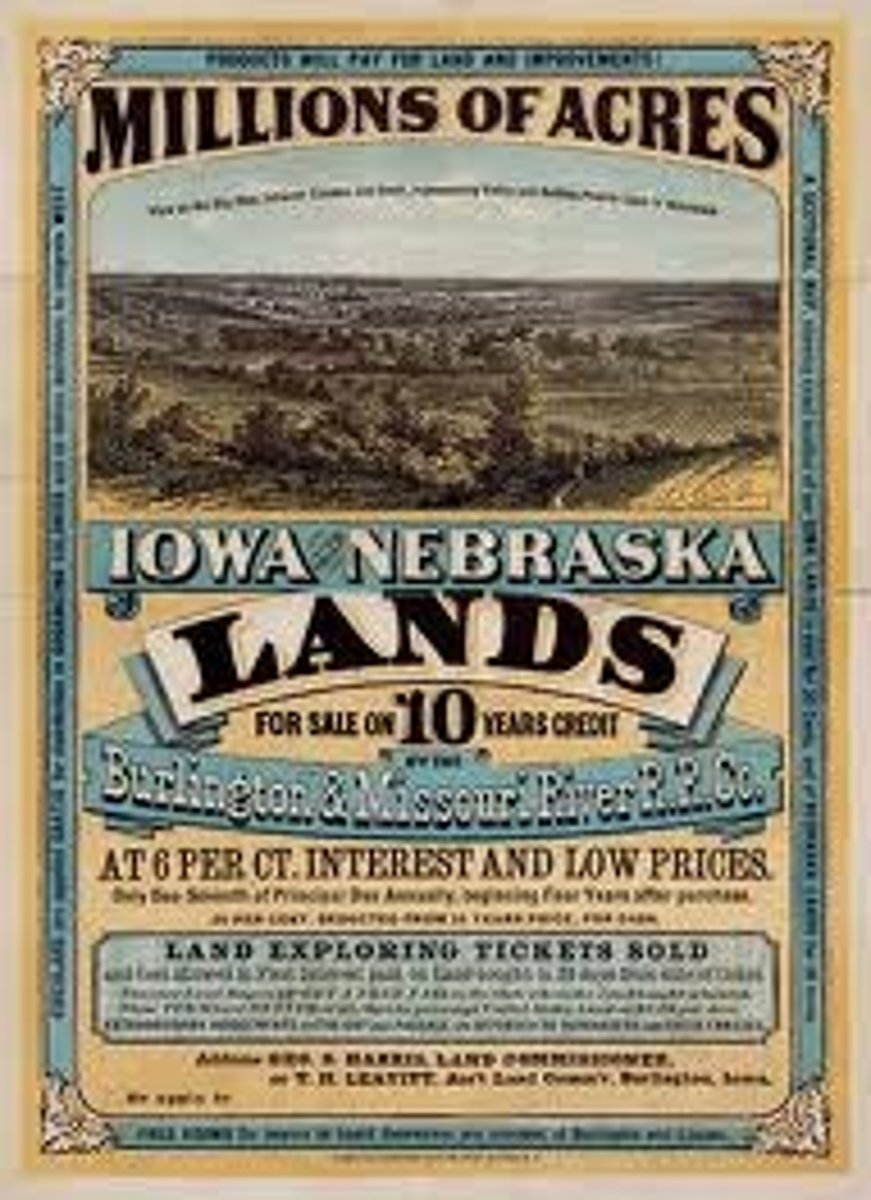American History
1/390
There's no tags or description
Looks like no tags are added yet.
Name | Mastery | Learn | Test | Matching | Spaced |
|---|
No study sessions yet.
391 Terms
Spain's New Laws of 1542
Key provisions:
- Forbade enslavement of Indigenous people and their compulsory service.
- Banned new encomiendas and prevented inheritance of existing ones.
- Declared Indigenous people free persons.
Colonial reaction: Colonists protested and even rebelled in Peru; similar threats occurred in Mexico. The Crown modified the laws in response to resistance.
Tomé de Sousa
Appointed by King João III as the first royal governor of Brazil in 1549.
Royal instructions / Indigenous policy
The king's instructions sounded benevolent on paper (protect and convert Indigenous people), but the policy was repressive in practice. Prohibited provoking wars with Indigenous peoples for the purpose of enslavement (rooted in medieval just-war ideas).
Bourbon Reforms
A series of economic, administrative and religious measures instituted by the Bourbon monarchs (1700-1824) in the Spanish American colonies.
The Bourbon Reforms were changes in Spanish America aimed at increasing royal control, efficiency, and profits. The Intendant system, borrowed from France, put peninsular-born officials in charge of finances, reporting directly to the Crown, while still answering to viceroys for other matters.
This displaced creoles from office and allowed the Crown to collect taxes more effectively. A colonial militia was created, giving prestige to creole elites, while high ranks were often bought by local aristocracy, and the fuero militar gave officers special legal privileges. The reforms also applied Enlightenment science, sending engineers and mining technicians to improve mining, including creating a College of Mining in Mexico.
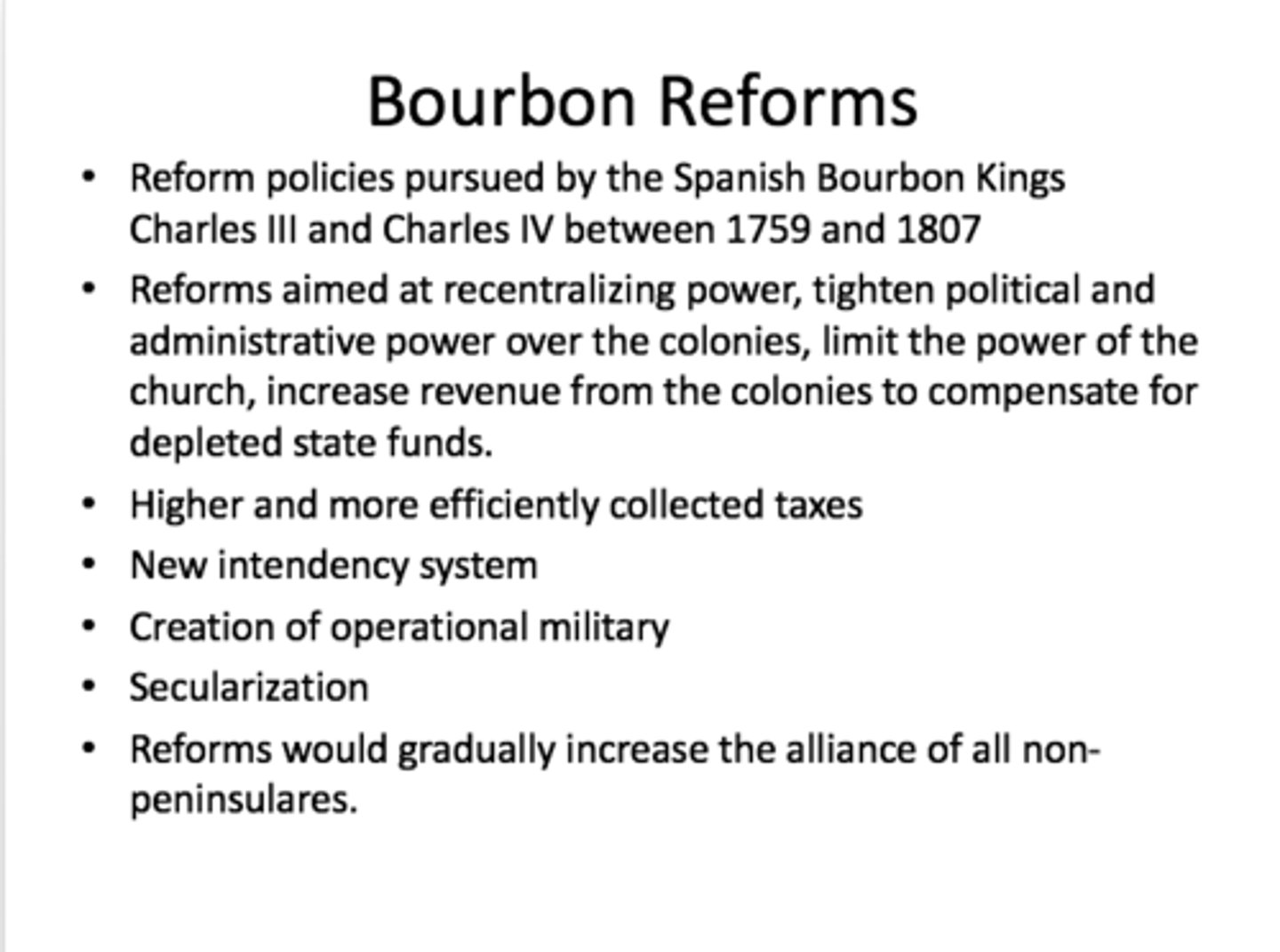
Pombal Reforms
a series of reforms intended to make Portugal an economically self-sufficient and commercially strong nation, by means of expanding Brazilian territory, streamlining the administration of colonial Brazil, and fiscal and economic reforms both in the colony and in Portugal.
He expelled the Jesuits in 1759, ended church-controlled Indian towns (aldeias), forcing Indians to speak Portuguese, adopt European dress, learn trades, and marry whites.
King Philip's War
King Philip's War (1675-1676) was a conflict between New England colonists (mostly English Puritans) and a Native American alliance led by Metacom (King Philip). Tensions over land, resources, and cultural control sparked the war, which involved attacks on towns and farms throughout southern New England.
The war was extremely destructive, with heavy casualties on both sides; 12 towns in Massachusetts alone were destroyed. The outcome crushed Native resistance in the region, resulting in displacement, death, and enslavement for many Native peoples, while securing colonial expansion and dominance in New England.
Richard Hakluyt
British writer who, in the 1580s, encouraged England to explore and settle in North America. His writings prompted England to embark on its North American empire.
Instrumental in promoting the economic, religious, and political benefits of establishing colonies in the New World to Queen Elizabeth I and the English public
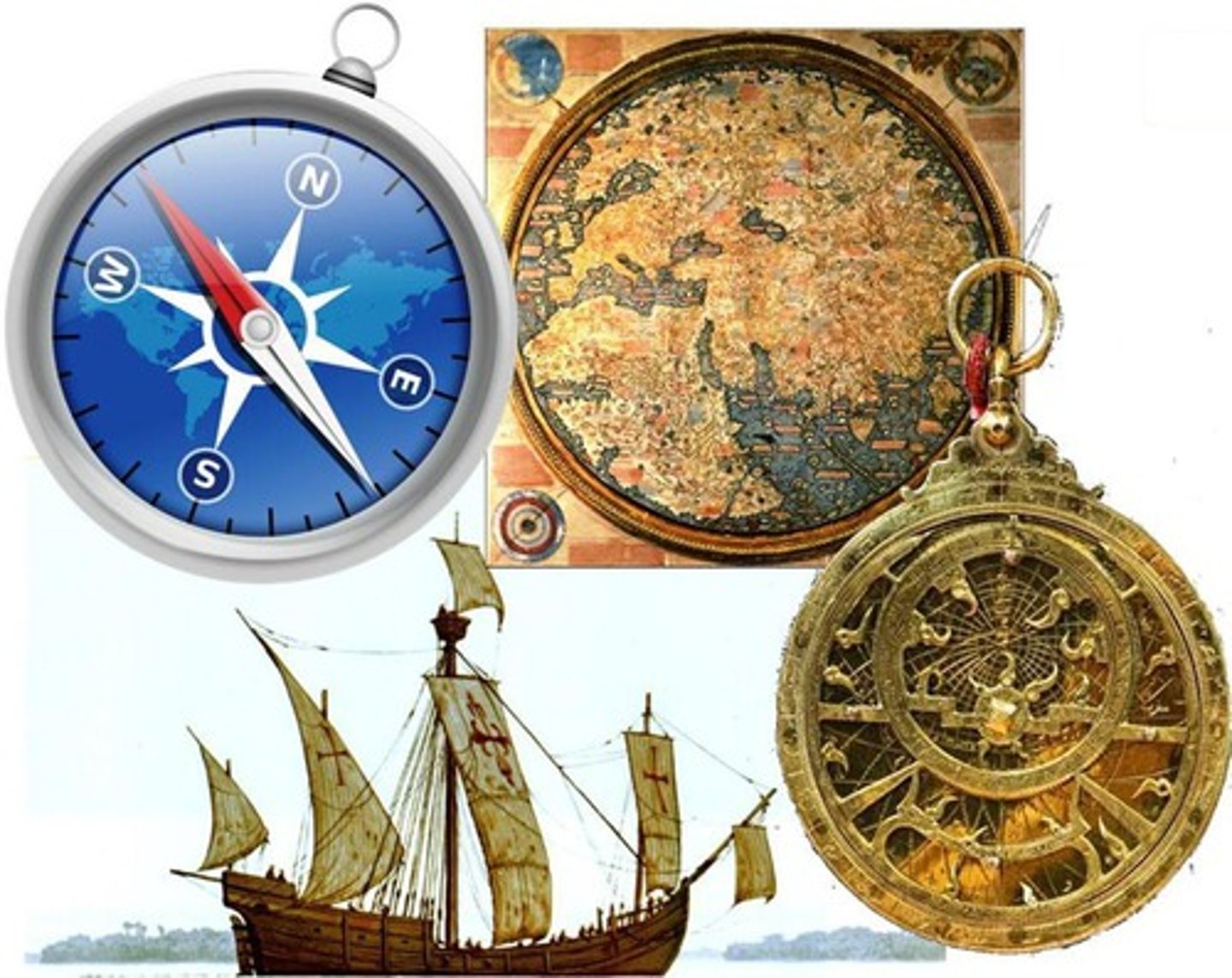
John Winthrop
As governor of Massachusetts Bay Colony, Winthrop (1588-1649) was instrumental in forming the colony's government and shaping its legislative policy. He envisioned the colony, centered in present-day Boston, as a "city upon a hill" from which Puritans would spread religious righteousness throughout the world.
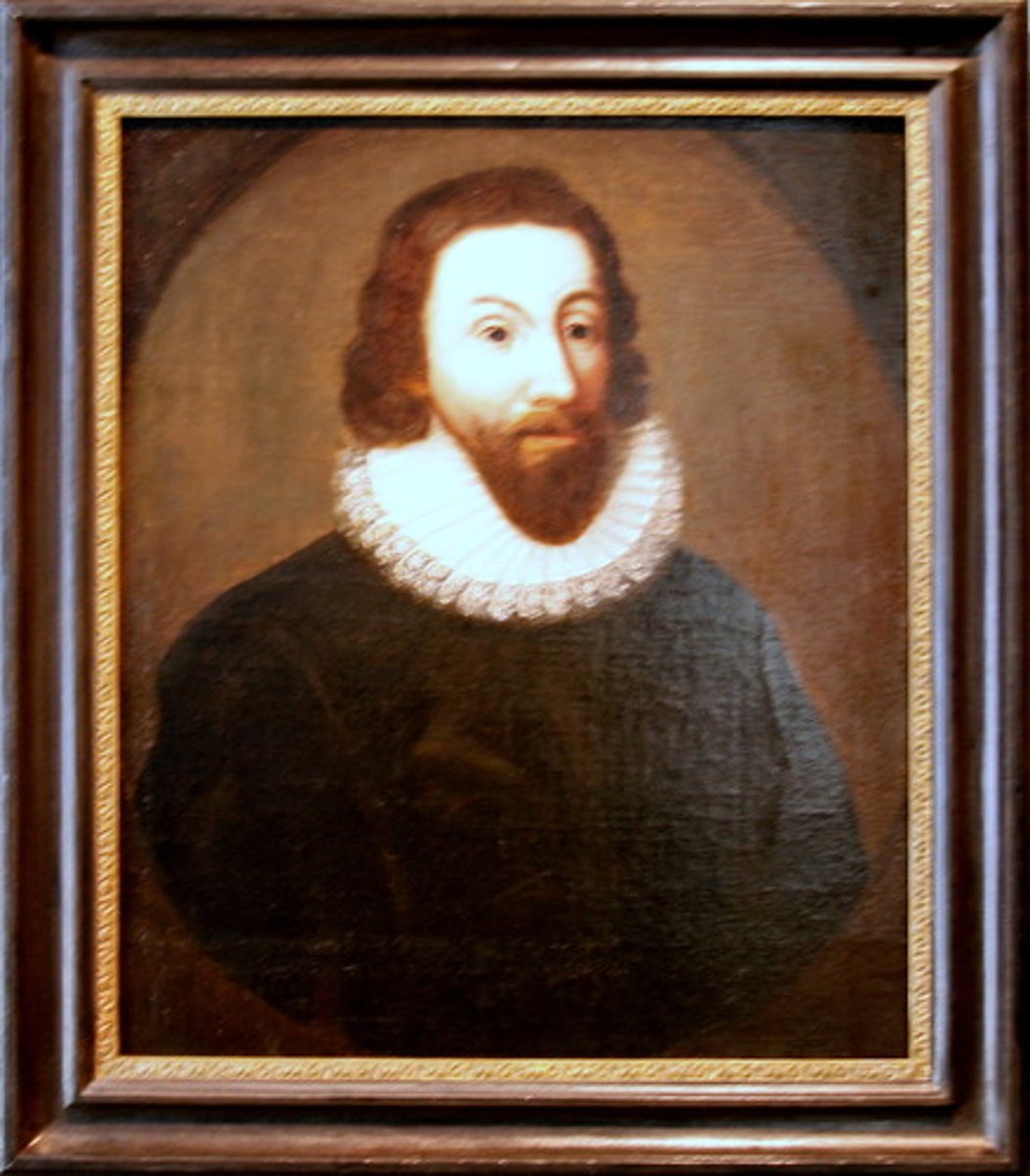
Mayflower Compact
1620 - The first agreement for self-government in America. It was signed by the 41 men on the Mayflower and set up a government for the Plymouth colony.
The Mayflower Compact was an agreement signed by the Pilgrims in 1620 that established a form of self-governance for the new colony of Plymouth
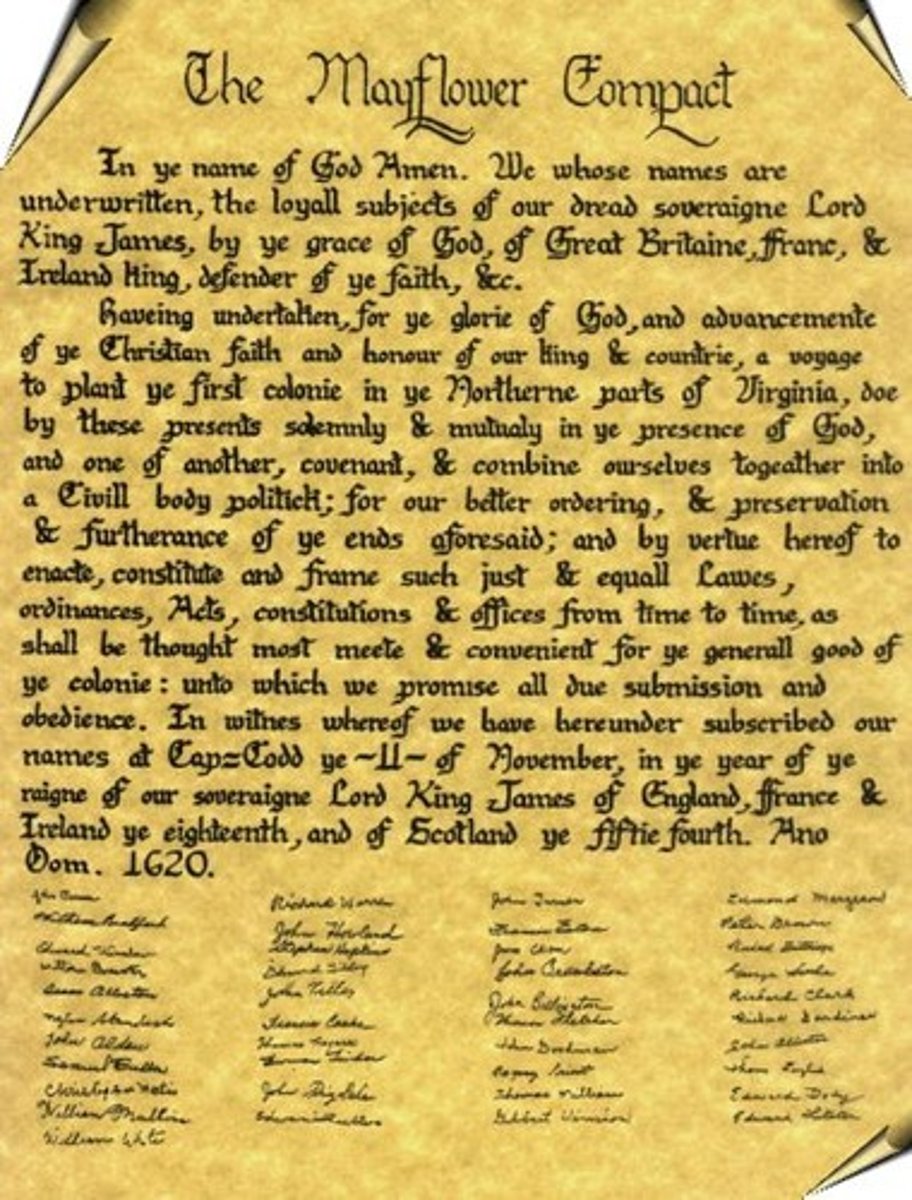
Dawes Act
An act that removed Indian land from tribal possesion, redivided it, and distributed it among individual Indian families. Designed to break tribal mentalities and promote individualism.
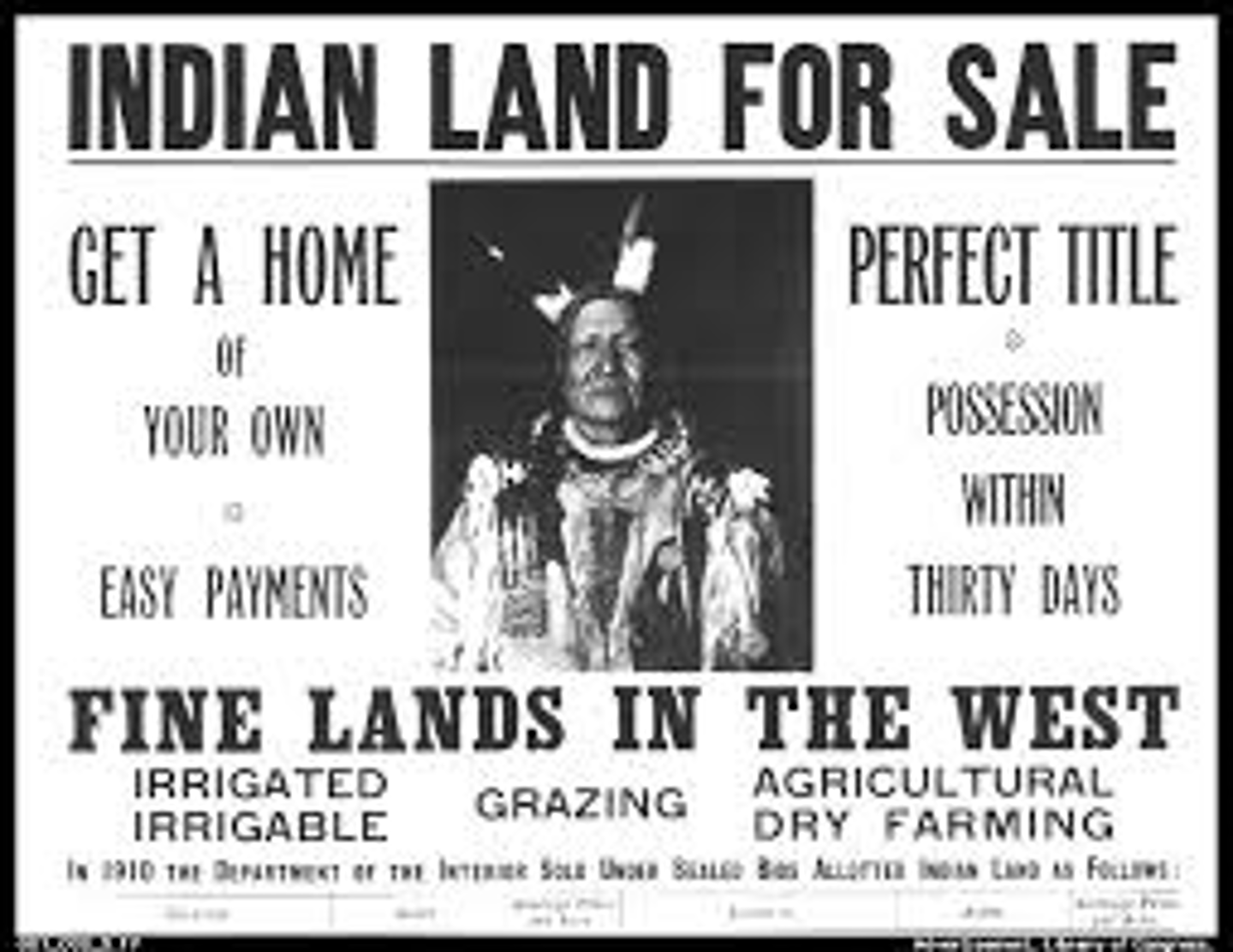
Sequoyah
Cherokee who created a notation for writing the Cherokee language (1770-1843) -- completed his Cherokee syllabary, enabling reading and writing in the Cherokee language.

Francisco de Miranda
Planted the seed of revolutionary ideas in Venezuela. Unable to get support. Returned with Bolivar to lead the revolution.
"I confess that much as I desire liberty and independence in the New World, I fear anarchy and revolution even more. God forbid that the other countries suffer the same fate as Saint Domingue ... better that they should remain another century under the barbarous and senseless oppression of Spain."
- Preferred continued Spanish rule over violent or destabilizing revolution, showing tension between liberty and social order.
Beliefs: Wanted liberty and independence from Spanish rule, but feared anarchy and social chaos.
Significance: Illustrates that not all independence leaders fully supported radical or immediate change. Reflects elite concerns: independence could threaten existing social hierarchies, even while seeking freedom from empire.
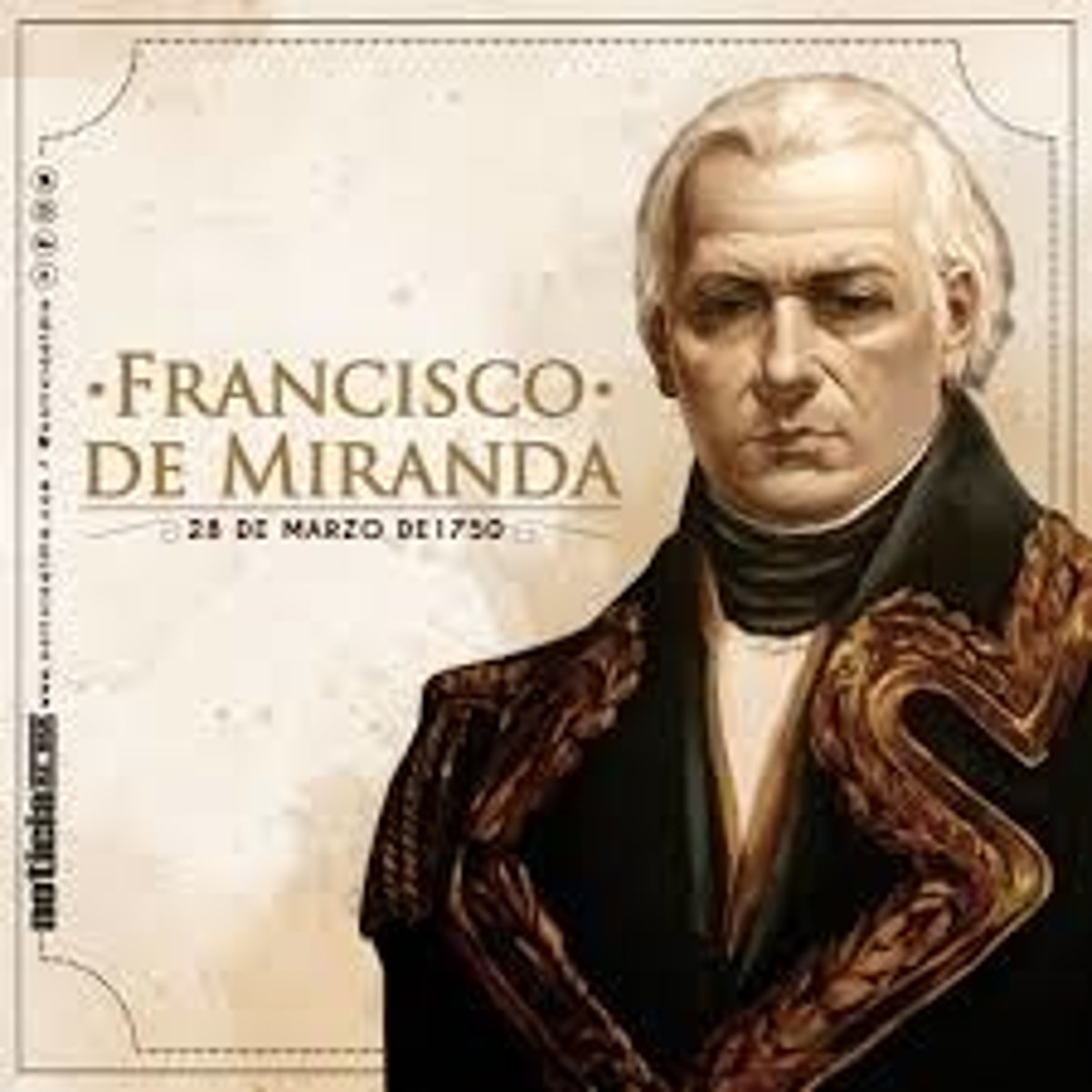
Quebec Act (1774): Escalation Toward Revolution
Its main goals were to secure the loyalty of French Canadians and establish a new government structure by allowing French civil law, granting religious freedom to Catholics, and extending the province's territory into the Ohio Valley.
However, the act was widely unpopular with American colonists, who saw it as an infringement on their rights and further evidence of oppressive British policies, which contributed to rising tensions leading to the American Revolution.
Quebec Act of 1774, which protected French Catholics' rights, angered colonists who saw it as favoritism toward former enemies.
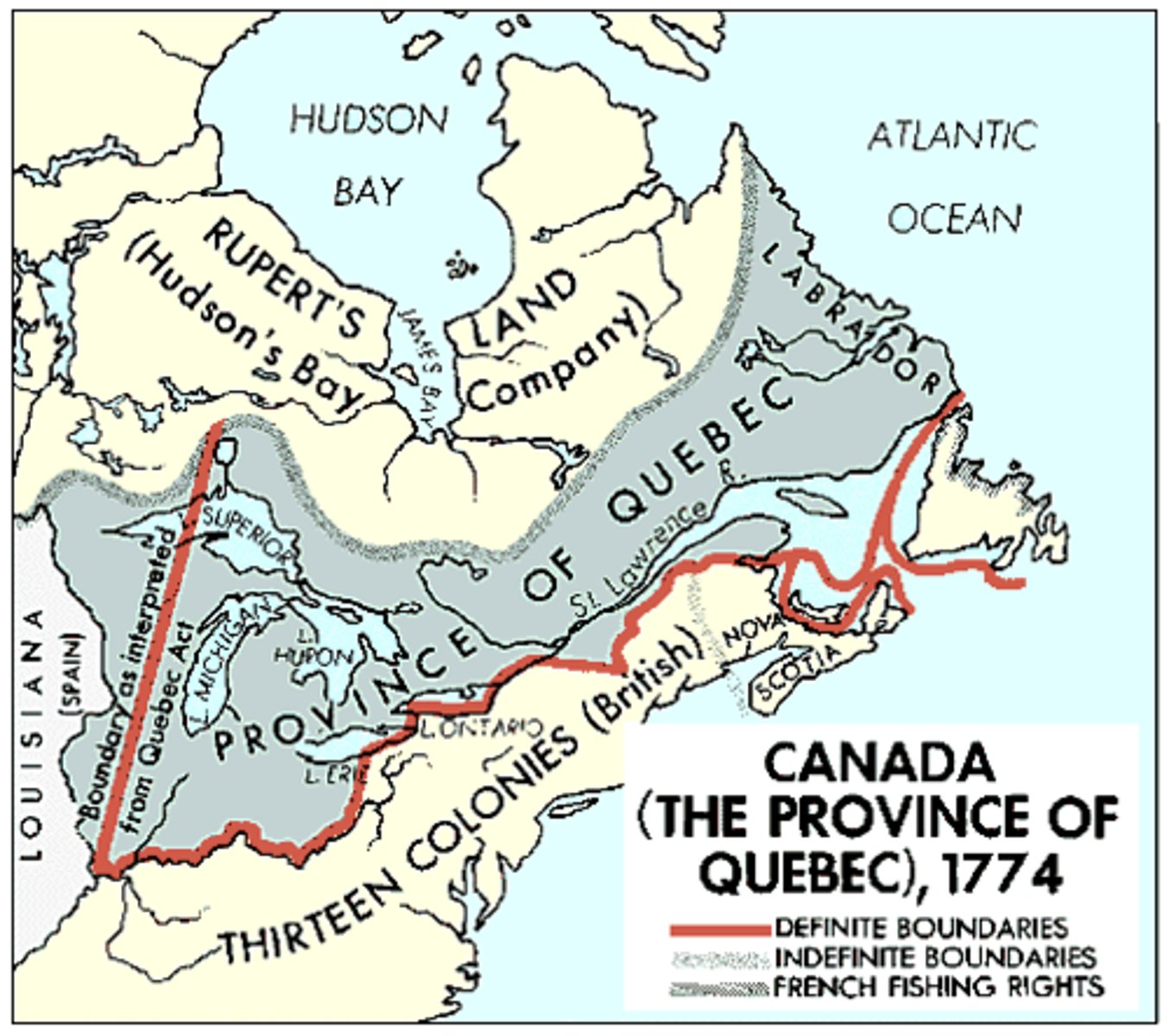
Committees of Correspondence
Organization founded by Samuel Adams consisting of a system of communication between patriot leaders in New England and throughout the colonies.
- Began in Boston, 1772 to share news and coordinate resistance.

Vermont constitution (1777)
only state to eliminate any kind of voting requirements (still only male); 1 house legislature; first state to abolish slavery.
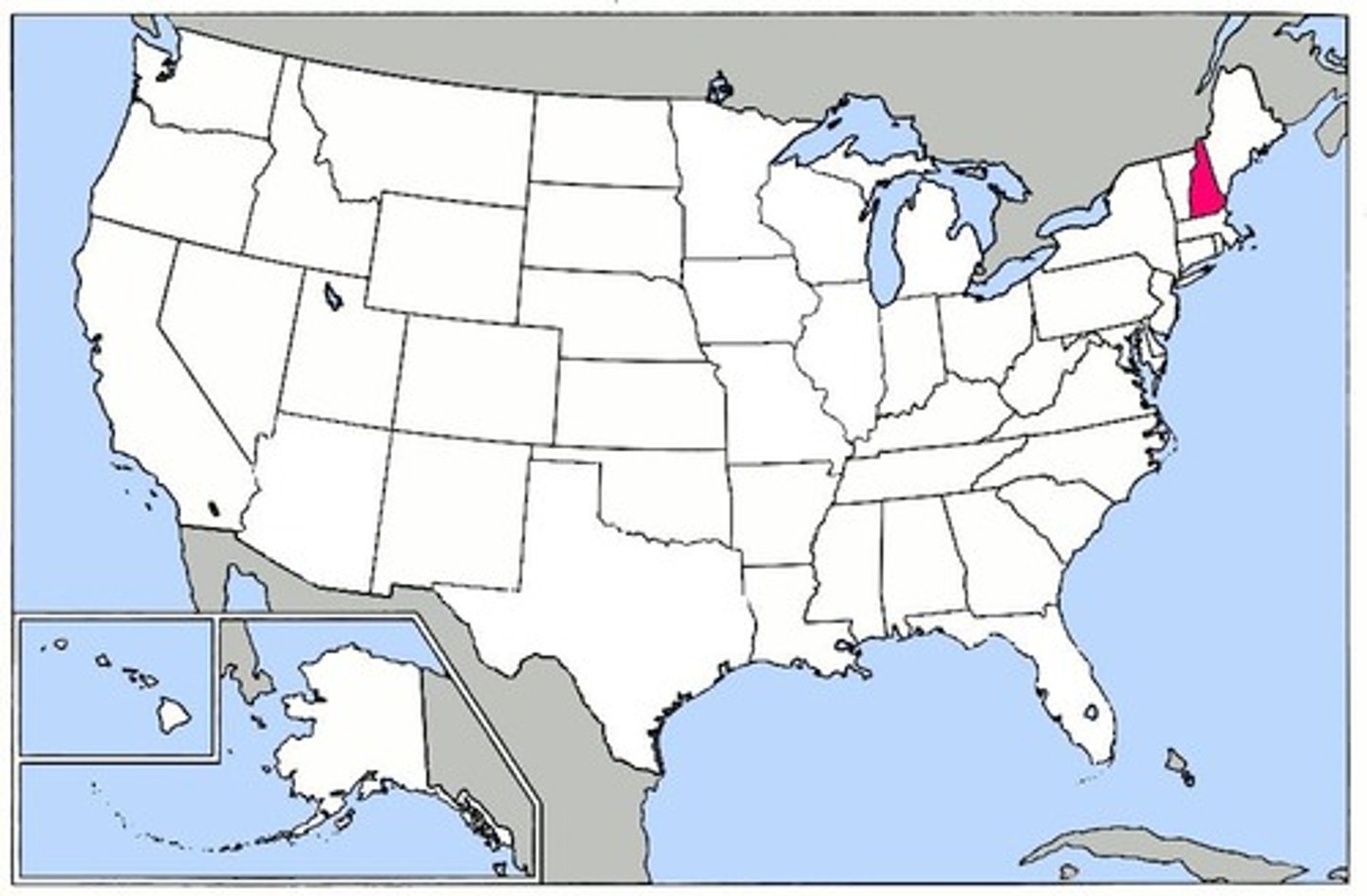
Nova Scotia during the American Revolution
Population: Mostly settlers from New England, including Massachusetts.
Local governance conflict (1774-1776): Tensions between colonial elite and governor.
Revolutionary sentiment: Lacked a sense of solidarity with Massachusetts revolutionary cause. Also, internal cohesion weak, sparsely settled, population spread out.
Protests and uprisings: Various protests in Halifax and elsewhere, but they did not coalesce into a movement.
Economic & strategic constraints: Dependent on trade with New England and Britain. Could not act independently or ally effectively with New England due to British naval power.
Nova Scotia stayed mostly neutral because it was loosely connected to the revolution, had weak internal cohesion, and lacked organizational tools (like committees) to join the rebellion, even though culturally and economically it was linked to Massachusetts.
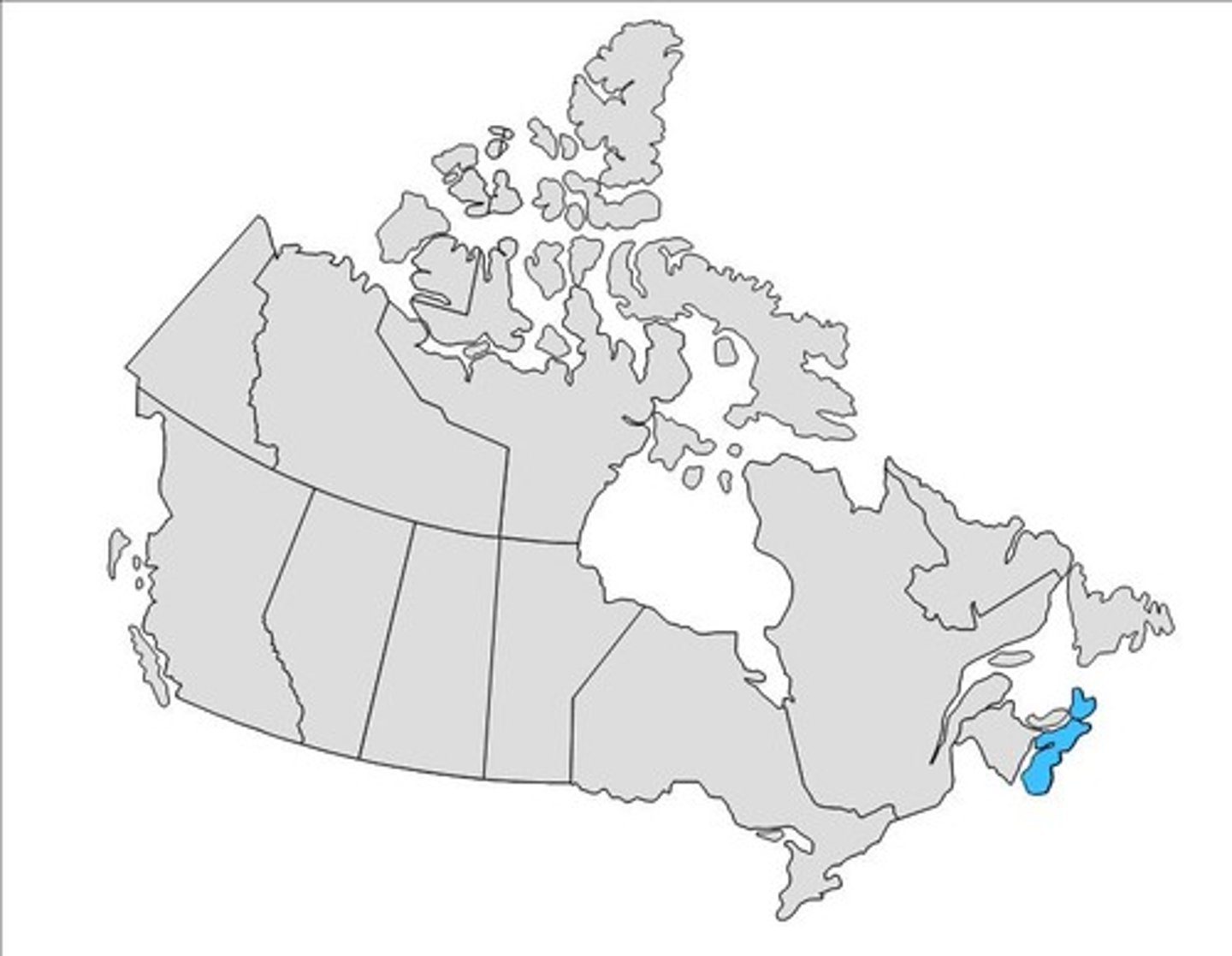
Quebec during the American Revolution
Population: Mostly French; some potentially unhappy under British rule.
American invasion (1775): Strategically weak and poorly supplied; defeated by stronger British forces. Americans received little support from Quebequois.
Propaganda failure: Americans failed to establish French-language communication to win local support. The Americans didn't create newspapers, pamphlets, or other communications in French to explain their cause and win over the French-speaking population. Americans were largely Protestant and often anti-Catholic, which made French Catholics in Quebec distrust them.
French landholders, clergy, merchants mostly neutral: neither actively supporting nor strongly opposing Americans.
The French population in Quebec mostly wanted stability or autonomy, not necessarily to join the American rebellion or fully embrace British rule. The Americans failed to gain local support in Quebec because of language barriers, religious differences, and the locals' perception of them as invaders.
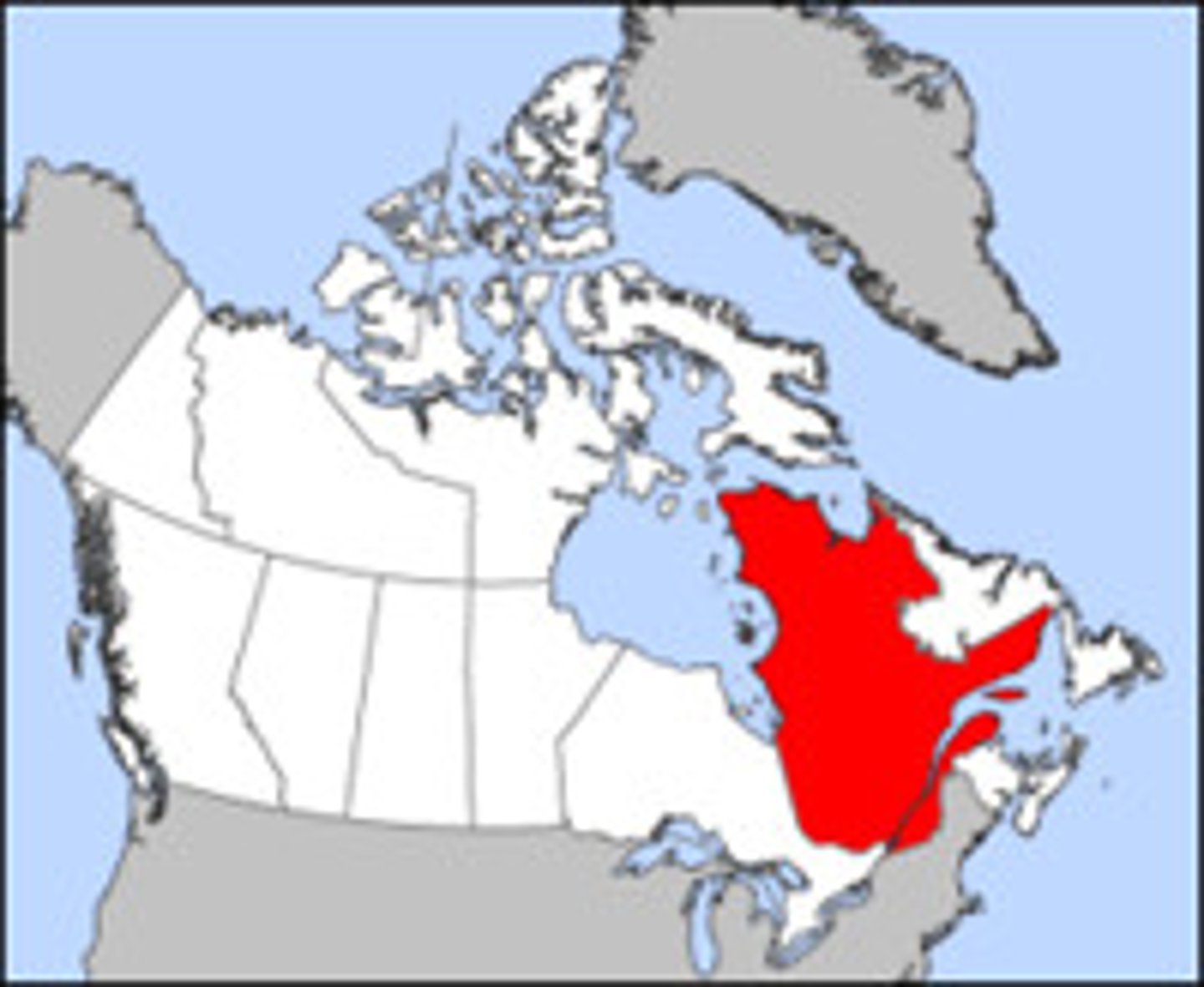
Articles of Confederation
A weak constitution that governed America during the Revolutionary War.
The Articles of Confederation was the 1st written constitution of the U.S. It was drafted in 1777 and officially ratified in 1781, serving as the framework for the national government during the Revolutionary War and until 1789. (first rulebook for how the states would work together.)
The Articles of Confederation created a very weak national government that couldn't solve the new nation's financial problems, maintain order, or represent the country effectively.

Cortes of Cadiz
Spain's first national sovereign assembly who created Spain's first constitutional; met during the French occupation of Spain.
Creation: A reconstituted Spanish government-in-exile, called the Cortes of Cadiz (a parliament), was created and convened in 1810 to rule in Ferdinand VII's name.
American Representation: 26 representatives were selected from the Americas. It still gave Creoles a formal political say in imperial affairs.
Core Principles: The Cortes stressed imperial unity, the Spanish language, and the Catholic religion.
Peninsular Demand: Peninsulares demanded a majority, proposing 1 deputy per 50,000 Spanish inhabitants vs. 1 deputy per 100,000 American Creole inhabitants.

The 1812 Constitution / Aftermath
Constitution that gives Creoles and Spaniards equal rights under independent nation.
Agreement: A Constitution was agreed upon, establishing real elections for a biennially elected legislature that would make law for all of Spain and Spanish America.
Suffrage: Most white, Indian, and mestizo men could vote. Exclusions: Blacks, mulattos, criminals, and servants could not vote.
Dissolution and Aftermath (1814)
Royal Reaction (1814): Napoleon was defeated and Ferdinand VII returned to the throne. Ferdinand immediately dissolved the Cortes, abolished the Constitution, and exiled or imprisoned 12,000 liberals (both American and Peninsular).
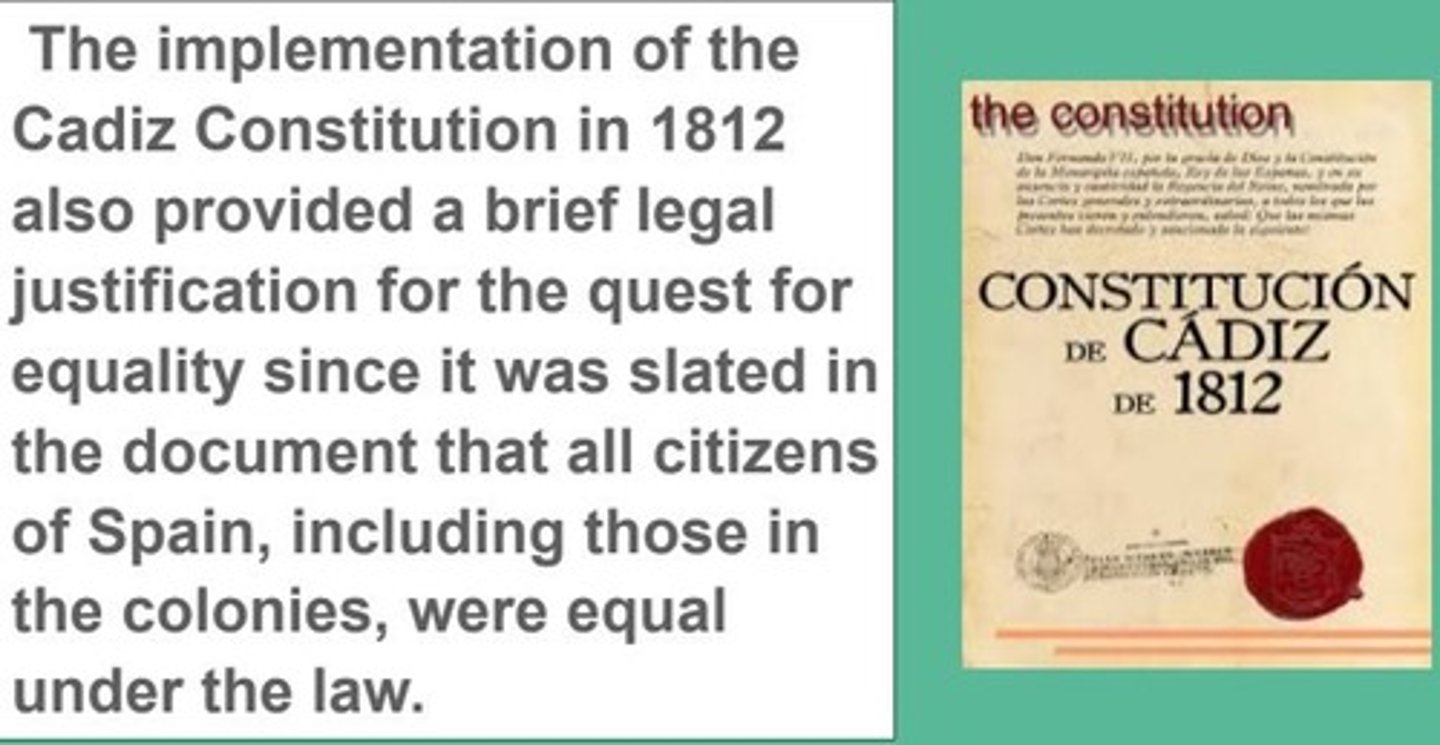
Caudillos
A Caudillo is a powerful, personalist military leader, similar to a strongman or dictator, who wields political and military power in Spain and Latin America. (likened to a warlord or military chief)
Independent leaders who dominated local areas by force in defiance of national policies; sometimes seized national governments to impose their concept of rule; typical throughout newly independent countries of Latin America.
By the 1830s, Latin America was mostly ruled by these military dictators from the creole class (American-born European-descendant).
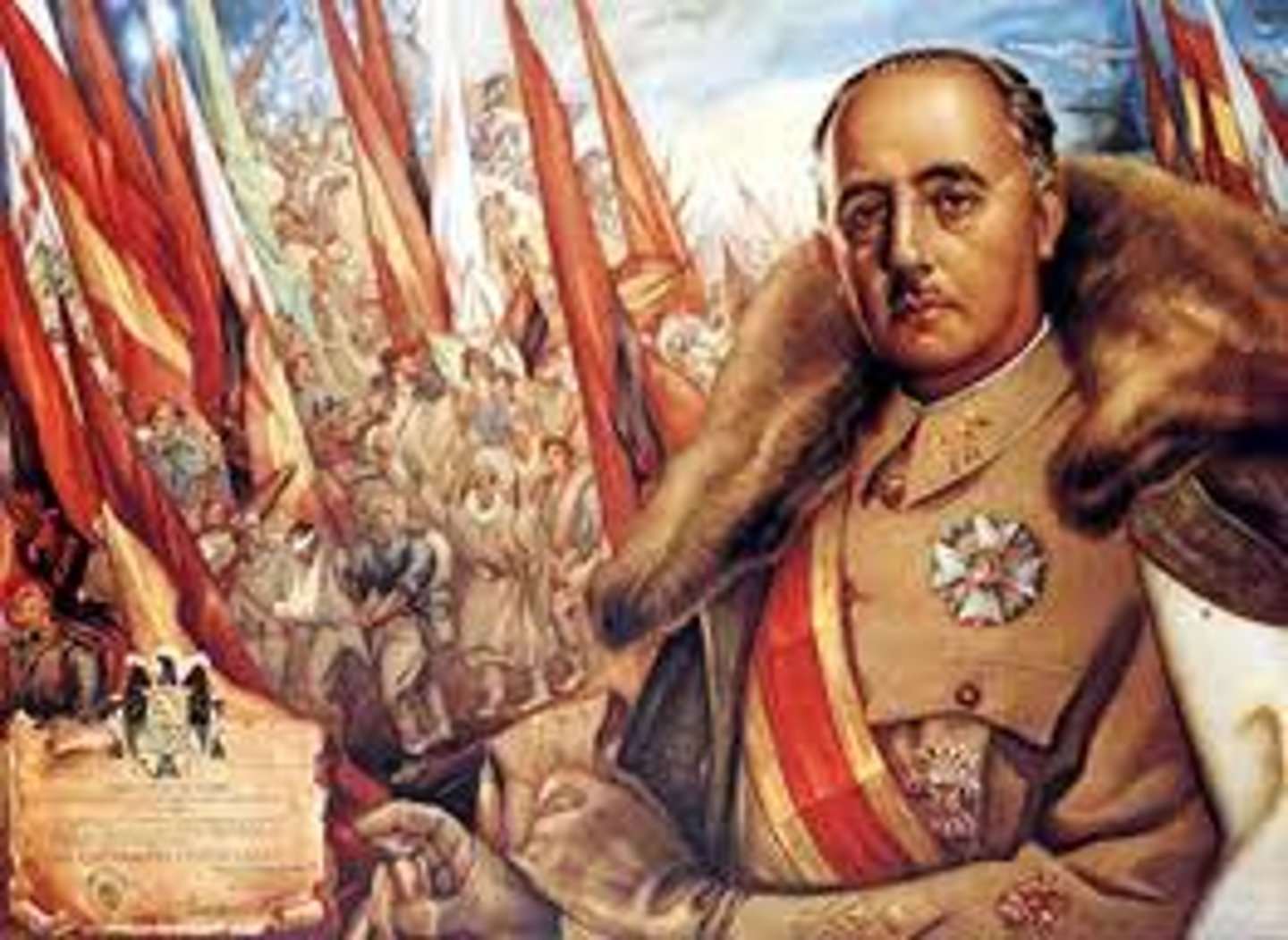
Julio Roca
Argentine General and President who spearheaded the Campaign of the Desert (1878-1885). This military campaign aimed to secure the vast Pampas and Patagonia regions by massacring or driving out the Indigenous populations living there.
The land was then redistributed to wealthy elites for agriculture and ranching, solidifying Argentina's identity as a commodity exporter and ensuring the dominance of the landowning oligarchy.
Whig Party
An American political party formed in the 1830s to oppose President Andrew Jackson and the Democrats, stood for protective tariffs, national banking, and federal aid for internal improvements.
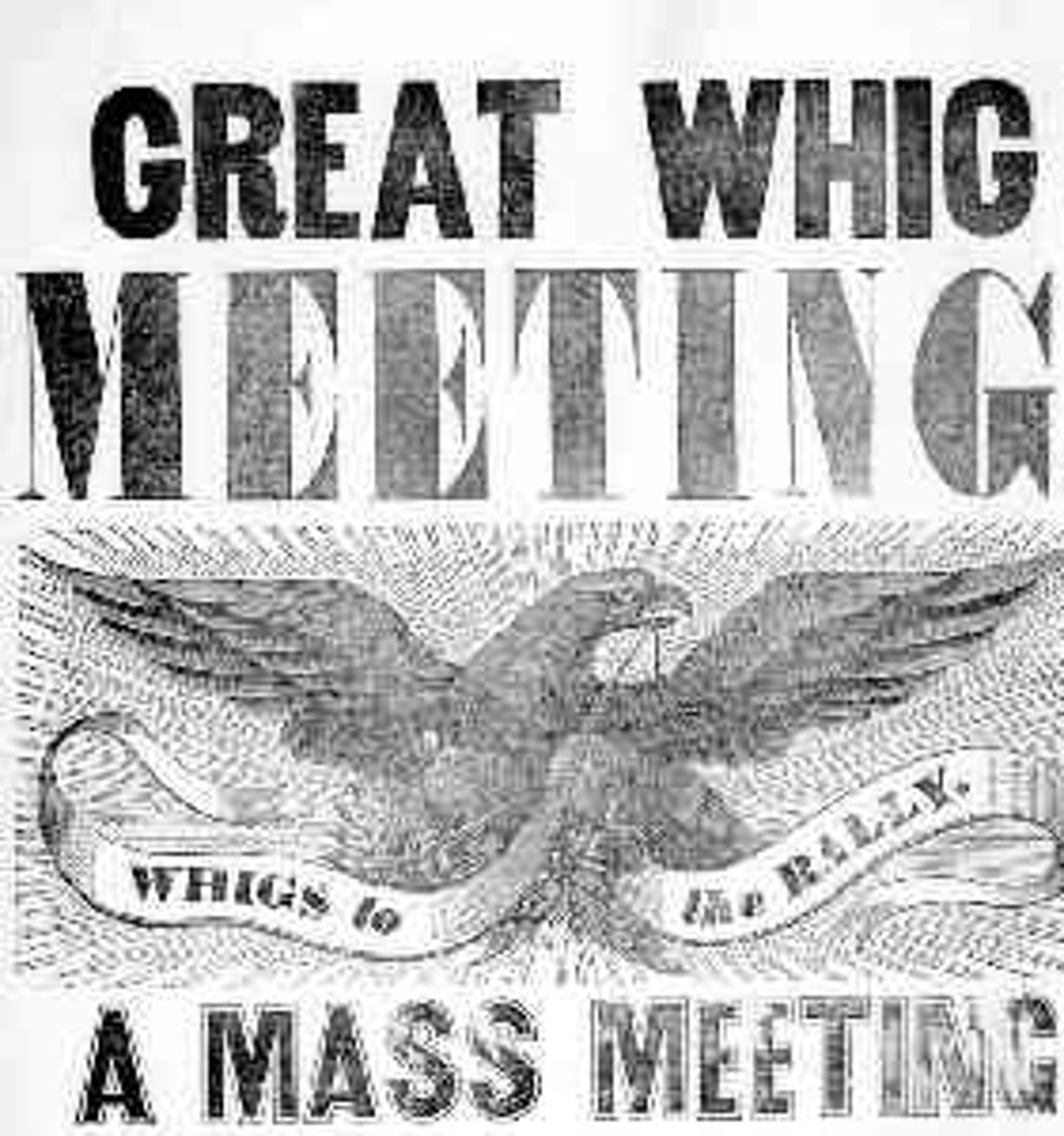
Nullification Crisis
Southerners favored freedom of trade & believed in the authority of states over the fed. gov.--> declared federal protective tariffs null and void; South believed individual state cannot defy fed. gov. alone; led to increased sense among Southerners as "minority" & threat of secession rather than nullification was the South's ultimate weapon

Migration and Donald Trump
2011: Political Arrival and the Birther Myth
Action: Promoted the Birther Myth, suggesting President Barack Obama was an immigrant and therefore an illegitimate president.
Key Theme: De-legitimization of political opponents and institutions. The focus is on who belongs and who can legitimately lead the country.
2015: Campaign Announcement
Rhetoric: Claimed Mexico was sending "Criminals and Rapists."
Key Theme: Association of migrants with criminality and immediate framing of migration as a threat to public safety.
2016: The Campaign Platform
Policy Proposals: Advocated for the construction of "The Wall" on the US-Mexico border and proposed a "Muslim Ban."
Key Theme: Policy as Physical Barriers and Religious/Ethnic Exclusion. The Wall serves as a tangible symbol of deterrence, while the ban targets a specific religious/national group.
2017-2021: Presidency
Policy Implementation: Implemented severe restrictions of asylum access, established large-scale detention camps, and enforced the separation of families at the border.
Key Theme: Deterrence by Cruelty and Policy Implementation. Actions aimed to make the process of seeking asylum difficult and dangerous as a mechanism of deterrence.
2024: Current Campaign
Rhetoric: Continued use of all previous themes, plus the phrase: "Migrants are poisoning the blood" of the country.
Key Theme: Escalation of Nativist Language. Reinforces the idea that migrants pose a biological or existential threat to the nation's identity and composition.

Shock Doctrine
a theory for explaining the way that force, stealth and crisis are used in implementing neoliberal economic policies such as privatization, deregulation and cuts to social services
critique of neoliberalism and the U.S. movement in forcing a free market economy.
Varying Working & Living Conditions
1. Plantations
Harshest conditions, long hours, brutal discipline, high mortality. (Work focused on crops like sugar, tobacco, and cotton.)
2. Urban Work
Roles included household servants (cooks, maids, nannies, butlers). Slightly better living conditions, sometimes allowed limited independence.
3. Mines
Work was extremely dangerous, exhausting, and unhealthy.
4. Skilled Labor
Enslaved carpenters, masons, blacksmiths, etc. Sometimes can make money.
Slavery Across Latin America
Brazil: Most intense and long-lasting center of slavery in Latin America.
Cuba: Another major slave society. (SUGAR BOOM)
Other regions:
- Slavery existed in Spanish America (e.g., Venezuela, Colombia, Mexico, Peru), but usually on a smaller scale.
Sustaining Slavery in Brazil
Creating divisions among slaves:
- Workforces fragmented by ethnicity and origin.
- African-born slaves (boçales): assigned the worst, hardest jobs (mostly field work).
- Brazilian-born slaves (crioulos): often given better jobs, especially if compliant, spoke Portuguese, or understood Portuguese culture.
Skilled labor opportunities:
- Lighter-skinned mulattos more likely to do skilled work.
Gender and freedom:
- Low female population slowed but didn't prevent creolization.
Creolization
foreign influences are absorbed and integrated with local meanings.
the process of two or more cultures or languages mixing to create a new, distinct one.
Resistance of Slavery in Brazil
Everyday resistance: Feigning sickness, malingering, breaking tools, sabotaging mills to reduce work or assert autonomy. Sometimes fled to neighboring plantations to escape cruel masters or overseers.
Social and cultural resistance: Used music, dance, and ritual to preserve African cultural and spiritual traditions within "popular Catholicism."
Comparison to elsewhere: Uprisings and rebellions also occurred, including on slave ships during transport.
Palmares Quilombo
Largest and most durable quilombo (runaway slave community) in Brazil. Formed in the early 1600s, estimated 20,000 people by the late 1600s.
Structure/Leadership: Network of spread-out communities, ruled by an elected "great lord."
Activities and social structure: Raided local plantations, but did not free all captured slaves, kept them in bondage following African practices.
Conflict with colonial powers: Six expeditions sent to capture Zumbi in the 1680s. King Pedro II of Portugal wrote to Zumbi, offering forgiveness and acknowledging the rebellion was justified by abuses of some slave-owners.
Legacy: Zumbi became an icon of modern Afro-Brazilian solidarity and resistance.
A quilombo is a community of escaped enslaved Africans and their descendants in Brazil.
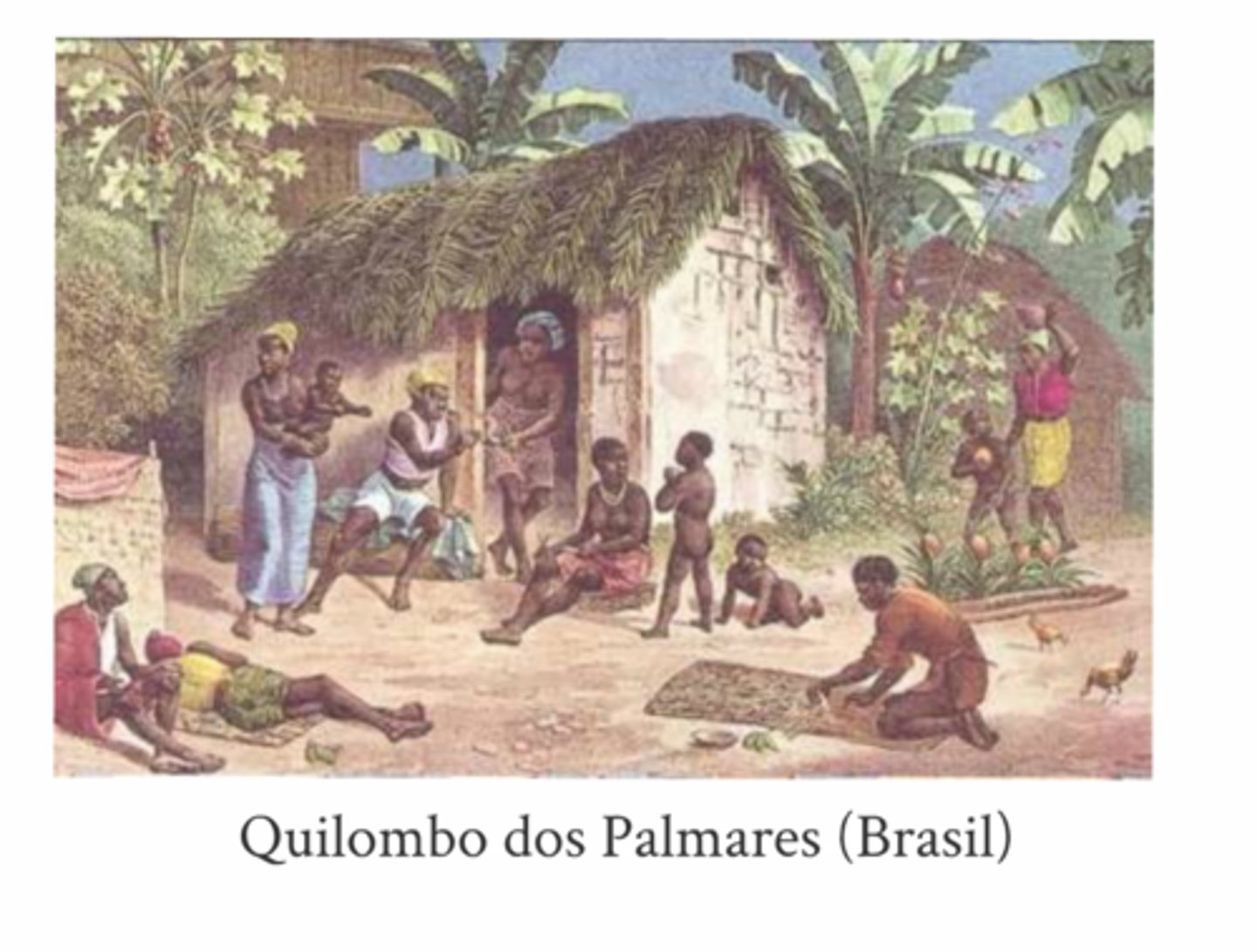
King Pedro II's letter to Zumbi
The king promised forgiveness for any "excesses" Zumbi had committed during Palmares' resistance. He also acknowledged that Zumbi's rebellion was justified because some slave-owners disobeyed royal orders and abused enslaved people.
- This reflects a common rhetorical strategy: portraying the monarch as benevolent and just, even when colonial systems were exploitative.
How Slavery Was Sustained
1. Armed White Violence
Planters, overseers, and militias used physical force to discipline slaves.
- Example: bandeirantes in Brazil actively fought runaway slaves and quilombos. The bandeirantes fight slave rebels.
2. White Creole Violence
Local-born whites (Creoles) participated in enforcement, not just European-born colonists.
Reinforced everyday control, punishment, and intimidation within communities.
3. Colonial/State Power
The colonial state provided legal backing, armies, and navies to protect slavery.
- Brit and French Army/Nacy especially necessary in Caribbean.
Slavery was not sustained by economics alone, it required systematic, organized violence at multiple levels: individual, local, and state.
Bandeirantes
Bandeirantes were explorers, slave hunters, and fortune seekers in colonial Brazil, mainly active from the 16th to 18th centuries.
- Hunted and captured Indigenous peoples and escaped enslaved Africans for labor.
- Explored the interior of Brazil, expanding Portuguese territorial claims.
- Sought gold, silver, and other resources in remote regions.
Motivated by resource extraction and the need for labor, they captured and "administered" Indigenous people, teaching them European farming and Catholic practices and treating them as property. Over time, expeditions became smaller but more frequent, engaging in paramilitary activities such as fighting the Palmares quilombo and Indigenous rebels during the War of the Barbarians (1683-1713).
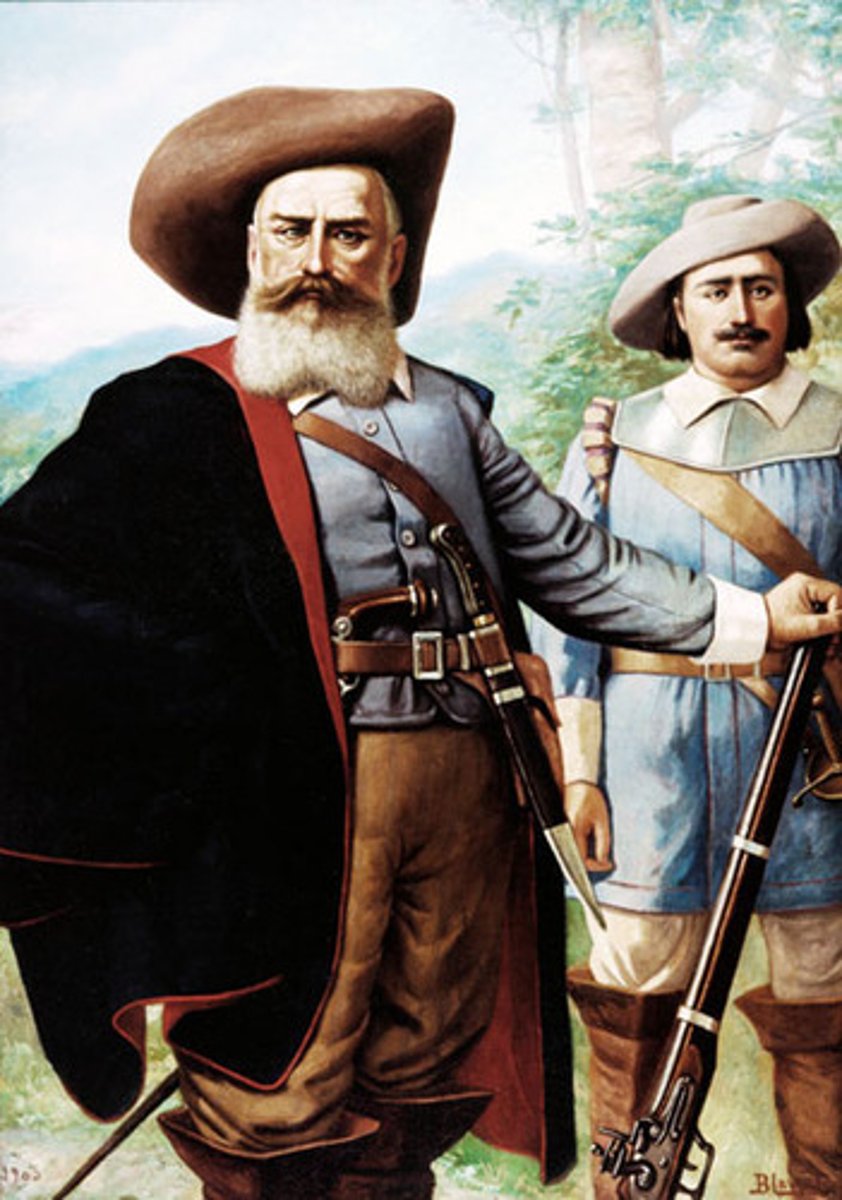
Limits of Slavery
Economic limits:
- Slavery can displace or block free labor, reducing incentives for wage work.
- Conversely, a strong free labor economy can limit the expansion of slavery politically.
Ecological and geographic constraints:
- Slavery is not equally profitable everywhere.
Environmental dimension ("green imperialism"):
Brazil, the Caribbean, and parts of South America = slave societies (slavery is central).
British North America / U.S. colonies = mostly societies with slaves (slavery is important but not foundational everywhere).
Basis of Iberian Power
(Iberia = Spain + Portugal) power
1. Institutions
- Power was built on strong, centralized institutions: The Crown (royal authority and colonial administration) AND The Church (religious conversion, education, and social control)
2. Social Strategy
When Spain colonized the Americas, it didn't completely destroy or replace the native systems of government right away. Instead, it took advantage of the fact that many Indigenous empires (like the Aztecs, Mayas, and Incas) already had organized, top-down hierarchies: rulers, nobles, tax collectors, and commoners.
Impact and Legacy of Colonial Rule in Latin America
1. Early Development: Colonial rule was especially formative in Latin America, it shaped how society, politics, and economy would look for centuries. Major cities like Mexico City and Lima were founded long before most cities in North America.
2. Long-Lasting Patterns:
- Hierarchical society: A small white elite (mostly of European descent) controlled wealth and power.
- Concentrated power: Political, social, and economic power was held by a few families or elites. The Catholic Church, which was also hierarchical, supported and justified this order.
- Economic structure: Large estates (haciendas) controlled by elites.
3. Independence
Latin American independence was driven more by international events (like wars in Europe, Napoleon's invasions, and shifting global power) than by internal revolts or reforms.
4. Comparison
North America (especially the British colonies) often had less rigid hierarchies and smaller gaps between elites and settlers.
Portuguese-Spanish rivalry and the "Discovery" of Brazil
1. Background: Competition for the Atlantic: Spain and Portugal were rivals in exploration, both wanted to control new trade routes and claim overseas territories.
- Treaty of Tordesillas: The line was later moved westward, giving Portugal more potential territory in the South Atlantic, including the future coast of Brazil.
2. The "Discovery" of Brazil: Evidence suggests this was not accidental: He may have been following earlier secret Portuguese voyages that had already hinted at land in that direction. (bird migration)
3. Aftermath: When word reached Lisbon, the Portuguese king quickly sent a major expedition to claim and explore the new territory.
Portugal chasing off the French
In 1532, the Portuguese founded São Vicente, the first permanent settlement in southern Brazil. To organize and defend their vast territory, Portugal created the captaincy system, dividing Brazil into regions governed by individual nobles. This helped maintain control and resist foreign claims. Although the French continued to challenge Portuguese authority along the coast until the early 1600s, the captaincy system ensured Portugal's legal and territorial claim over Brazil remained secure.
But captaincy system poor at colonization...
By 1550, only 2 of the 12 Portuguese captaincies in Brazil were successful. The most prosperous was Pernambuco, where sugar production developed around Olinda, the first major export from the Americas to Europe besides the gold taken from the Aztecs and Incas. In the south, settlement expanded with the founding of São Paulo in 1554.
--> To stabilize the colony, the Portuguese Crown reclaimed failing captaincies and sent more settlers, including some deported from Portugal for crimes like witchcraft, bigamy, or Judaism, similar to exile practices in British North America.
Economics: Gold and Economic Expansion
Early Spanish/Portuguese focus: gold — valuable, easy to transport.
Mines: Hispaniola → New Granada (~30 million oz total by 1600).
Brazil: Minas Gerais (18th century) → 32 million oz, majority of Western world supply.
Economic impact: inland urbanization, Baroque culture, migration of Portuguese settlers (1700-1760, ~½ million).
Minas Gerais → largest Black population in Brazil; diamonds discovered 1729.
Gold-rush economy: transient; many failed to prosper.

New Wealth of 1700s Brazil
Economic impact: Gold and other resources revitalized Portugal, which was otherwise in decline.
Political/administrative changes: Rio de Janeiro became the capital in 1763. (Main port for the mining regions)
Labor and social conditions: Slave mortality in mining districts was even worse than on plantations. Formation of quilombos (runaway slave communities). Existence of paid slave catchers as a counterforce.
Mining districts had a male-heavy gender imbalance (Led to concubinage and prostitution).
Many Miced-raced illegitimate children.
Demographics: By 1776, free blacks made up about 1/3 of the population
Economics: Silver
Importance: Silver was the main source of Spain's wealth during the colonial era. Mining drove exploration, settlement, and expansion of Spanish territories.
Major deposits: Potosí (Bolivia), Mexico... Over the colonial period, Latin America produced 100,000 tons of silver.
Demographics and urbanization: In 1670, Potosí was the largest city in the New World (160,000 inhabitants), surpassing Lima, Mexico City, New York, Quebec, and Recife.
While mineral wealth brought enormous riches to Spain, Portugal, and their colonies, it also had significant downsides. Inflation was especially severe in Spain, and much of the wealth extracted from the Americas seemed to leave the region, often flowing to Europe. A popular joke suggested that African slaves mining Brazilian gold in the 1700s funded the English Industrial Revolution, since the gold was sold to England in exchange for manufactured goods.

Encomienda
The encomienda system was a Spanish colonial system where the Crown granted colonists (encomenderos) the right to Indigenous labor and tribute in exchange for teaching them Christianity and "civilizing" them. A Spanish encomendero was the person granted control over a group of Indigenous people under the encomienda system.

Bartolomé de la Cases
Dominican missionary who advocated for Indigenous rights.
Returned from the Caribbean to Spain in 1515 to plead the Indians' case to the king
Reported Spanish abuses and portrayed Indigenous people as innocent rather than savage (the "innocent vs. savage" dichotomy)
Won debates in Madrid and Rome about Spanish policy and the theological value of Indigenous people

Repartimiento
Spanish labor system in Latin America, supposed to replace the encomienda system, in which native communities were compelled to provide laborers for the farms or mines and the Spanish employers were expected to pay fair wages.
Temporary allotment of Indigenous workers by the colonial state.
Religion and Native Americans in Brazil
Jesuits and their role: Catechize Indigenous people, Live in native villages, not just Portuguese settlements, Learn Indigenous languages, Establish missions for converted Indigenous people.
Advocacy and conflicts: Jesuits often defended Indigenous people against Portuguese settlers' attempts to use them as slave labor.
Limitations and other forces shaping Indigenous life: Jesuits unintentionally spread diseases, which affected concentrated populations in missions.
Impact: Early successes in conversion, especially among women and their children. Helped spread Christianity into the interior of Brazil.
Jesuit goals:
- Tried to turn semi-nomadic Indigenous people into settled agriculturalists
- Lived in mission villages and taught Christianity, European farming, and social organization.
Conflict with colonists:
Rift between Jesuits and colonists: Colonists wanted to enslave Indigenous people for labor Jesuits protected Indigenous populations, sometimes having final authority over mission villages.
- The Crown allowed colonists to enslave Natives captured in "just" wars, creating a legal loophole
Brazilian Slavery: Shift from Native to African
Shift in labor source: Decline of the Indigenous population created a labor shortage.
African slave trade: Brazil became part of the pre-existing African slave trade. Slaves captured, bred, and shipped from Africa.
Economic impact: By the early 1600s, the Brazilian economy was dominated by slave labor. By 1810, 2.5 million African slaves had been brought to Brazil. (largest importer of slaves worldwide)
Dutch Brazil
In 1630, the Dutch occupied Pernambuco in Brazil, having previously attacked Bahia in 1624, as part of their ongoing conflict with Spain during the Eighty Years' War (1568-1648) for Dutch independence. The Dutch forces leveraged alliances with Indigenous and Black groups to strengthen their position against the Portuguese, using local support to challenge Portuguese control in the region.
Other forms of labor
1. Wage labor: Emerged as the repartimiento system became difficult to manage and prone to favoritism. Workers were paid wages, though conditions could still be harsh.
2. Hacienda system / debt peonage: Workers tied to haciendas through debt peonage. Debts or advances kept workers from leaving for better jobs.
In short: The hacienda system is the estate/plantation, and debt peonage is how landowners ensured workers stayed and kept working.
Control of Land in Spanish and Portuguese America
Shift in sources of power: Early colonial power came from control of labor, which was scarce and valuable. Over time, control of land became another major source of wealth and influence.
Displacement of Indigenous people: Indigenous populations were pushed off fertile lands onto marginal hillsides and mountains.
Methods of acquiring land: Spaniards and Portuguese used legal and administrative tactics: - Demanded Indians show legal title to land they already lived on
- Concentrated Indians into villages, freeing up land for colonists
- Claimed land through surveys
Controlling land became central to colonial wealth and power, often at the expense of Indigenous populations and productive use of the land.
Spain and Portugal came to rely on the New World
Dependence on exports: Spain and Portugal relied heavily on Latin American raw materials for trade and wealth. Brazilian exports sometimes made up 2/3 of Portugal's total exports.
- Prosperity depended on international market prices.
Production methods: Generous land endowments meant elites and the Crown did not invest in improving production.
Spain and Portugal came to rely heavily on the New World for raw materials, using Latin American goods like sugar, cotton, gold, silver, diamonds, hides, woods, tobacco, and cacao to support Iberian foreign trade. In Brazil, exports often made up two-thirds of Portugal's total exports.
- Both the Iberian countries and their colonies became dependent on international market prices for their prosperity. However, because land was abundant, elites and the Crown did not invest in improving production methods, which soon became outdated and inefficient.
Spanish America
Spain controlled its colonies through a hierarchical bureaucracy, including the Council of the Indies, viceroys, audiencias, and captaincies, overseeing law, trade, and the Church. Despite this centralized structure, distance and slow communication gave local officials and creoles significant autonomy, especially in municipal government. Trade was tightly controlled through Seville, Cadiz, and the asiento system, showing Spain's focus on extracting wealth for the empire rather than local development. Over time, creoles managed most local affairs, which kept the colonies stable but also gave them the experience and influence that would later fuel independence movements.
Role of the Church
Conversion as central goal: Being Spanish or Portuguese meant being Roman Catholic.
Crown control over the Church: Spanish and Portuguese monarchs had special roles in the New World church: Collected and spent church funds, Appointed church officials, Defined bishopric boundaries...
Integration of Church and state: Clerics often held top administrative positions in colonial government.
Church organizations: Priests and lay brotherhoods (voluntary groups for charity: schools, hospitals, orphanages) Voluntary associations of the faithful for a (usually charitable) purpose: school, hospital, orphanage.
Colonial Society in Spanish and Portuguese America
Family and gender roles: Society was deeply patriarchal; men were heads of households. Women expected to maintain sexual purity and were legally treated as minors.
Education and culture: The Church was the main source of education and cultural preservation.
Social hierarchies and racial mixing: Iberian/peninsular elites vs. creoles/mazombos (locally born whites). Mestizo and mulatto populations emerged from Indian, African, and European mixing. Society was highly stratified by race, birth, and legal status.
Mestizo
A person of mixed Spanish and Native American ancestry.
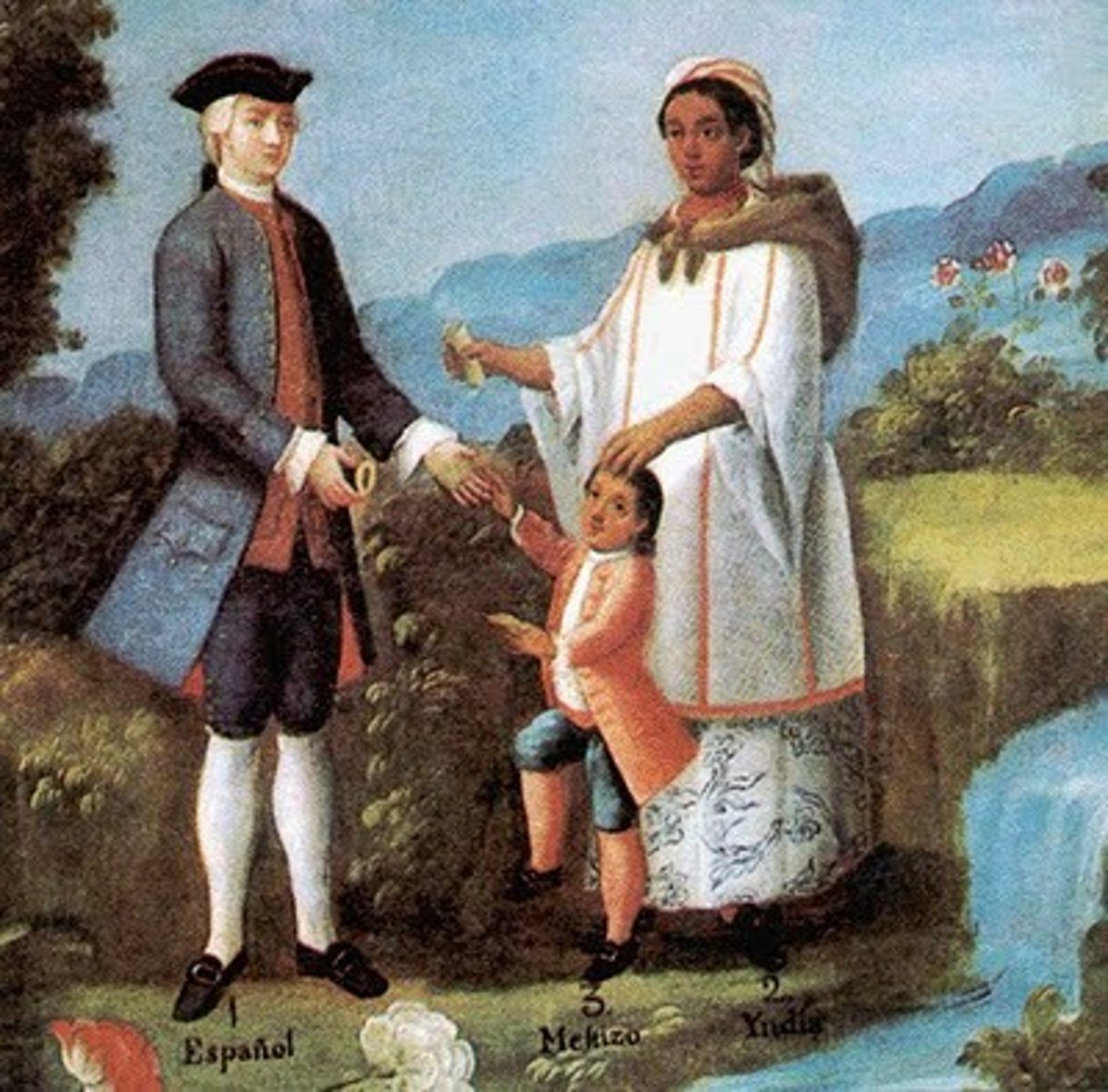
Brazil's Economic Ascendance over Portugal
After 1780, Brazil's gold mining declined, and the economy began diversifying into domestic markets, small-scale manufacturing, agriculture, and merchant activity. The Portuguese crown worried that the royal fifth (quinto) was being evaded, seeing declining payments as smuggling rather than a drop in production.
At the same time, Portugal faced economic problems: it became increasingly dependent on Britain, suffered from inflation, failed to invest in domestic industry, relied on British textiles, had an inadequate merchant fleet, and still had to recover from the Lisbon earthquake of 1755. The overall effect was that Brazil's economy grew more robust relative to Portugal's, shifting the balance of wealth and power within the empire.
Colonies and Metropole
In the Spanish and Portuguese empires, colonies were generally discouraged from producing goods that the mother country already made, keeping them dependent on Spain or Portugal. By the late 1700s, however, many creole elites began questioning whether this relationship truly served their interests. At the same time, social hierarchies persisted: Iberian elites ignored the needs of creoles, and creoles largely ignored the majority of the population, showing how wealth and power were concentrated at the top.
The Founding and Economic Development of the American Colonies
The colonies were not founded with a single purpose. Instead, North America saw a variety of beginnings, leading to distinct regional identities.
A. New England
Massachusetts: Founded by Puritans seeking to escape religious persecution and create a religiously pure society.
Rhode Island: Founded by Roger Williams and others to escape the strictures of the Massachusetts Puritans, promoting religious freedom.
B. Mid-Atlantic
New York: Originally New Amsterdam, a Dutch trading post focused on the fur trade, before being taken by the English.
Pennsylvania: Founded by William Penn as a haven for Quakers, based on principles of religious tolerance and pacifism.
C. Southern
Virginia: The first permanent English colony, founded by a joint-stock company for economic profit (initially searching for gold).
Maryland: Founded by Lord Baltimore as a proprietary colony and a refuge for English Catholics.
Carolina: Founded by settlers from Barbados in 1670. They brought the harsh Barbadian slave code with them, establishing a slave-based society from the outset.
Georgia: Founded as a buffer colony to protect the Carolinas from Spanish Florida, initially serving as a haven for debtors and with an early ban on slavery.
Separation of Church and State
Revolutionary Era: Many American leaders were Deists (e.g., Jefferson, Franklin, Washington). A Deist is someone who believes in God as a creator but rejects organized religion and supernatural involvement (like miracles or divine revelation).
After Independence: No national church was established under the new U.S. Constitution.
Gradual Change: State-level established churches (like in Virginia and Massachusetts) were slowly disbanded through the late 18th and early 19th centuries.
Virginia - (Founded 1607)
Settlement: Jamestown, established 1607, the first permanent English colony in North America. (Early years = disaster)
Leadership and Survival: John Smith (1608) kidnapped Powahatan.
Relations with Powhatan Confederacy: Tense but necessary trade relationships developed afterward.
1619: First enslaved Africans arrived in Virginia.
Indentured Servitude: Main labor source during the early 1600s.
Headright System: Colonists received 50 acres of land per person whose passage they paid for.
Caribbean settlements
British: Barbados, Jamaica (conquered from Spain in 1655)
French: St. Domingue (modern Haiti)
Economic: Main crop: Sugar — becomes the main economic engine of these colonies.
Early labor: Poor and working-class European migrants (mainly English, Irish, and Scottish). Often bound by indentured servitude, debt contracts, or convict transportation (forced migration as punishment).
Shift to African Enslavement: Colonists turned to the African slave trade for a more "disease-resistant" labor force. Enslaved Africans quickly became the backbone of plantation labor throughout the Caribbean.
Carribean: The economic center of both British and French colonial empires in the New World. (Sugar was extremely profitable and in high demand in Europe.)
- The mainland North American colonies. like New England, the Carolinas, and Louisiana, developed economies that supported the Caribbean sugar islands.
Summary
Caribbean colonies were wealthy but brutal plantation societies. Sugar transformed them into global economic powerhouses.
The shift from indentured servitude to racial slavery reshaped the Atlantic world. These islands were central to the growth of European wealth and empire, often more valuable than the mainland colonies.
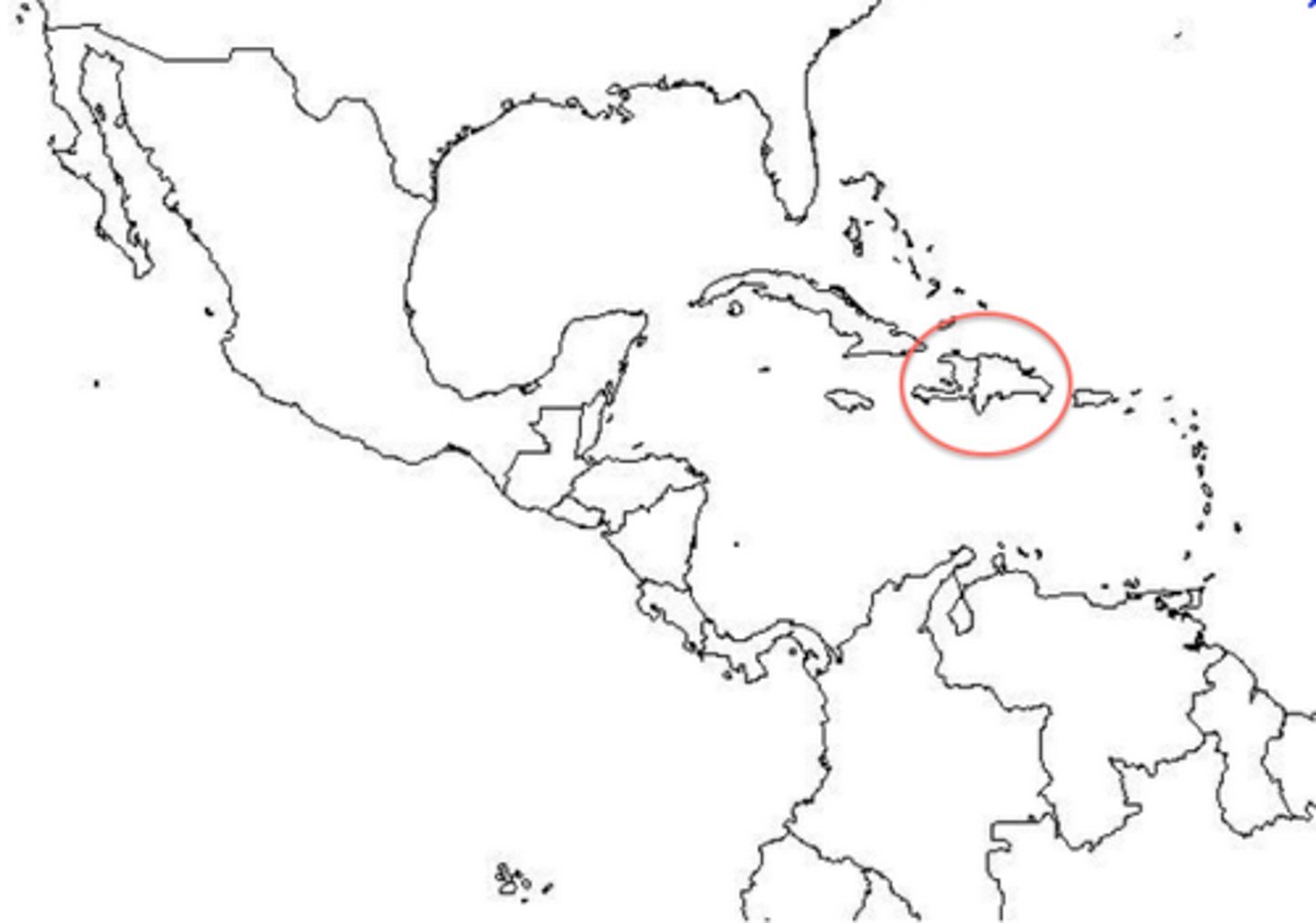
How Did Definitions of Race Differ Across Colonial Powers?
British: Tended toward rigid racial boundaries ("one-drop rule"), clear division between white and nonwhite. British North America → slavery strictly tied to African ancestry.
Spanish: Created complex racial hierarchies (casta system) recognizing many mixed categories (mestizo, mulatto, etc.). New Spain (Mexico, Peru) → race affected taxes, privileges, and marriage rights.
Portuguese: Somewhat more fluid racial mixing than British, but still maintained social hierarchy favoring Europeans. Brazil → wide range of mixed-race identities but deep inequality.
French: More flexible early on, especially in Louisiana and the Caribbean, but hardened over time with slavery.

Colonial Region: New England
New England - This is the region, not a single colony. It includes Massachusetts, Rhode Island, Connecticut, New Hampshire, Maine, and sometimes Vermont. Think of it like "the Northeast area of the colonies."
Plymouth was the first permanent colony of Europeans in the New England region.
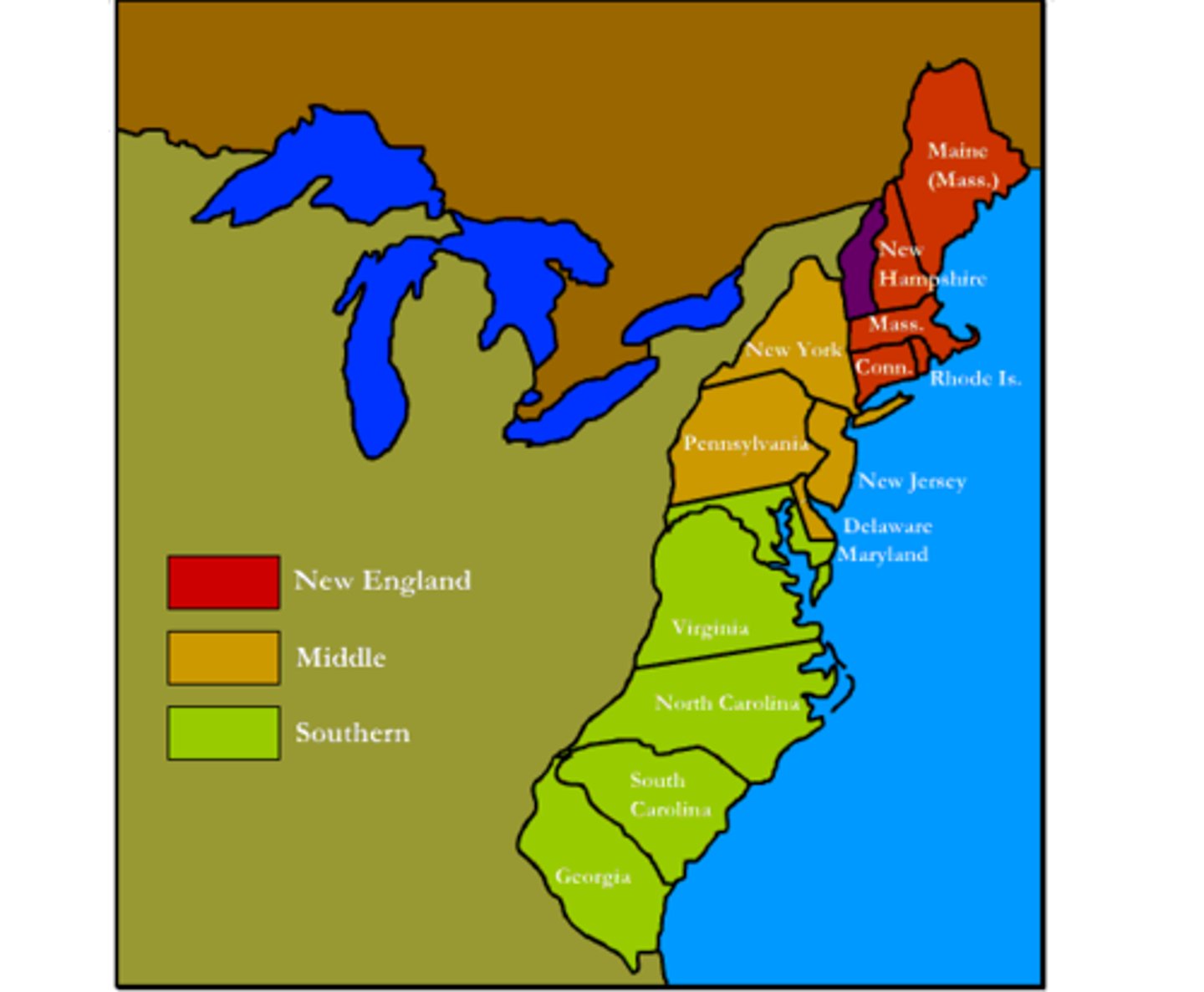
The Eliot Indian Bible
It is the first Bible printed in any language in North America and the largest single printing venture of the early colonial period. It was prepared by English Puritan missionary John Eliot by translating the Geneva Bible into Massachusett. (worked on it for 15 years)
Despite this achievement, the "Eliot Indian Bible" also represents the failure of the Puritans to fully convert Native Americans to Christianity and reshape their lives.
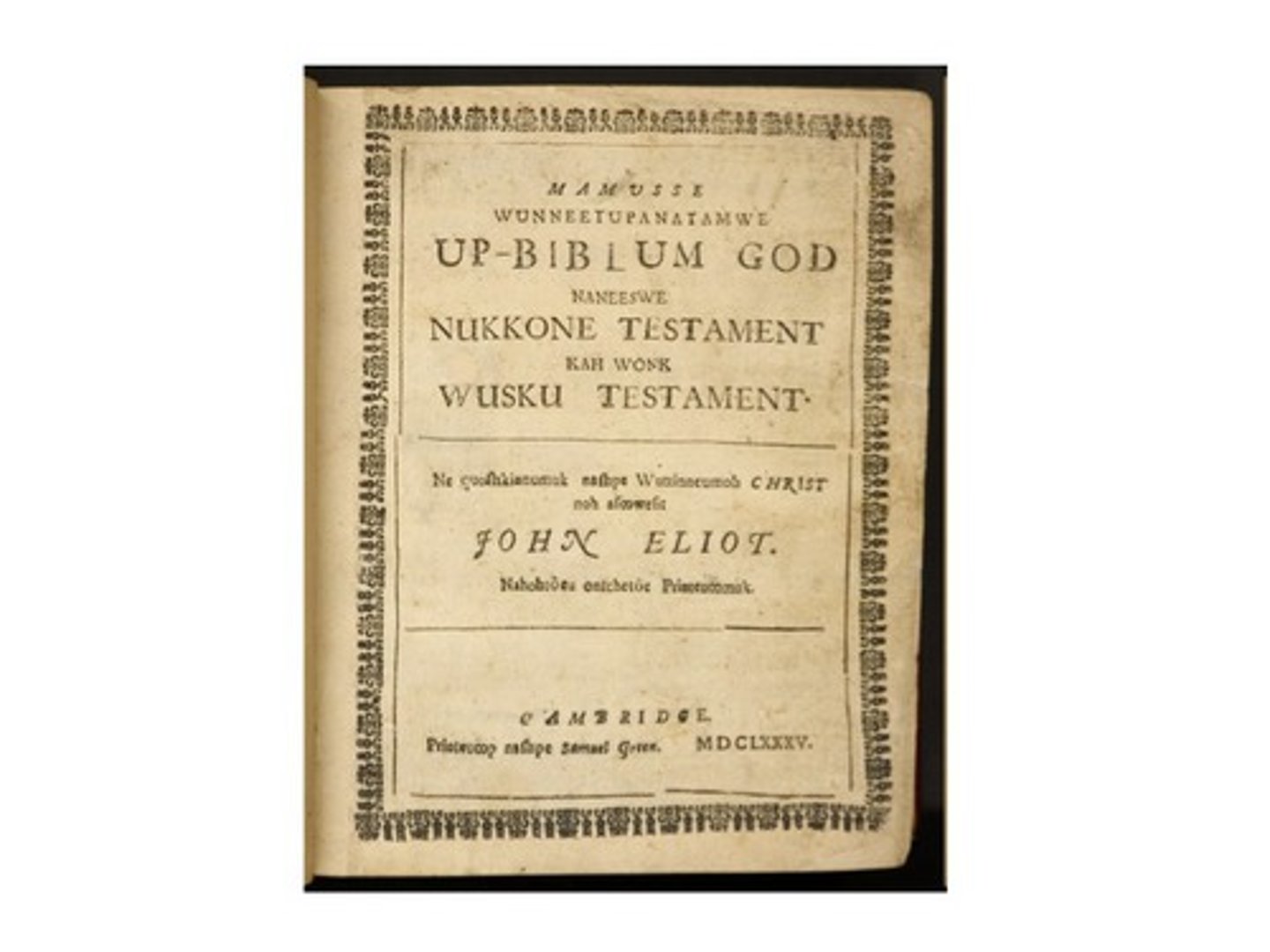
Calvinism
Protestant sect founded by John Calvin. Emphasized a strong moral code and believed in predestination (the idea that God decided whether or not a person would be saved as soon as they were born). Calvinists supported constitutional representative government and the separation of church and state.
A belief that only a chosen few (the "elect") will be saved, but very few such people and most don't know their fate. One can however, see signs of "conversion" (God's grace in your life) and then live a sanctified life as a "visible saint" (which meant feeling God in your soul and demonstrating this to your fellow Puritan church members).
God selected a limited number of souls to grant salvation and there's nothing any individual person can do during their mortal life to alter their eternal fate.

Calvinism and Its Influence in the Colonies
Colonial followers: Puritans (Massachusetts Bay), Dutch Reformed, French Huguenots, Scotch Presbyterians.
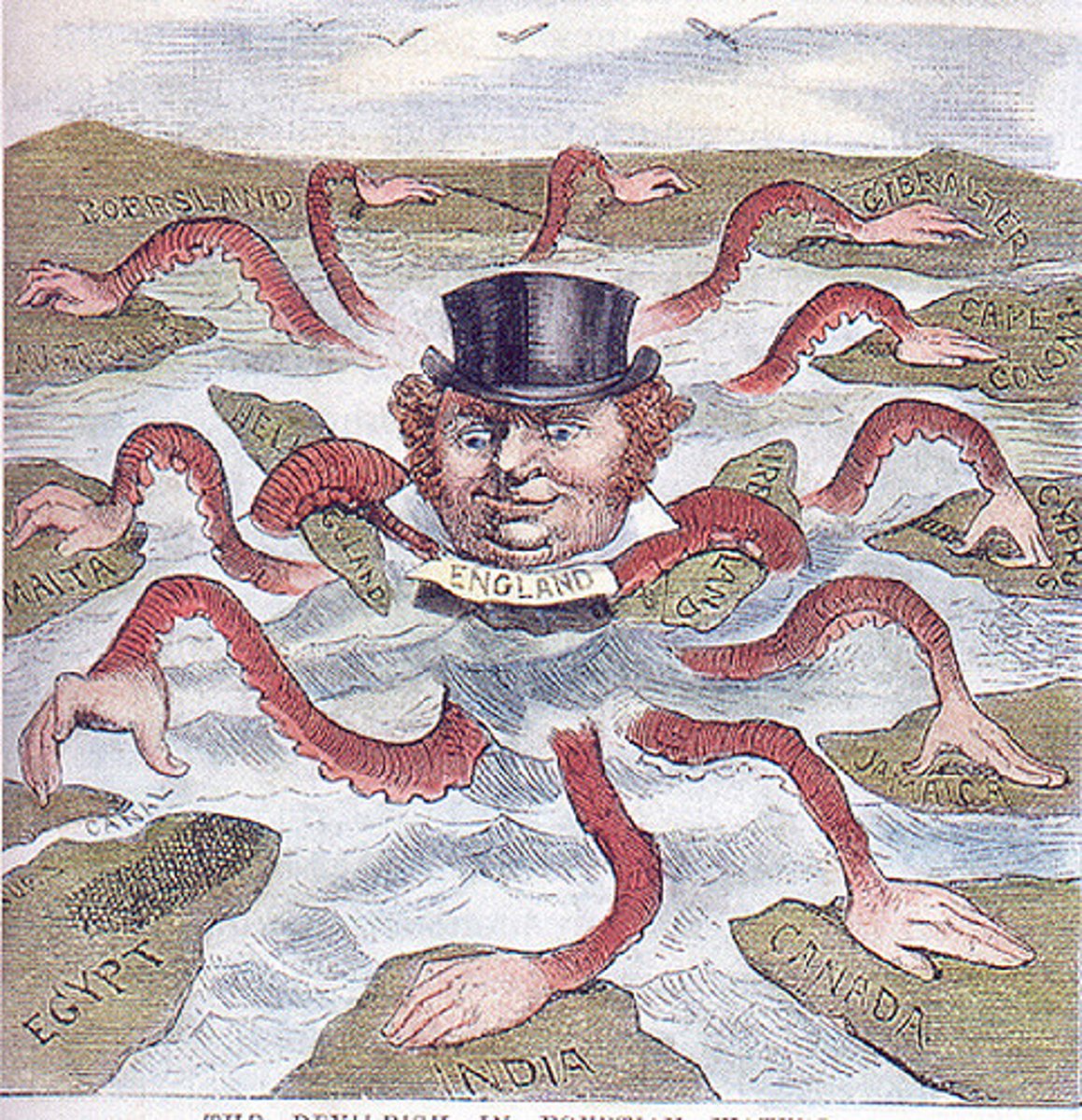
New England Primer
Schoolbook used by the New England Colonists to teach reading and writing.
(It was a tool to teach children the Puritan worldview, shaping them into obedient, pious, and disciplined members of a religiously governed society.)
1. Values Conveyed in the New England Primer:
Religious devotion: Frequent Bible verses and references to God emphasize faith and piety.
Moral discipline: Lessons stress obedience, hard work, honesty, humility, and self-control.
Law and order: Children were taught to respect authority, follow rules, and live orderly lives.
Education and literacy: Reading was a moral and spiritual duty, not just a skill.
Community responsibility: Emphasized the role of the individual in maintaining a godly, orderly society.
2. What This Tells Us About Puritan Culture
Highly religious: Daily life was dominated by God, scripture, and moral conduct.
Structured and disciplined: Puritans valued order, hierarchy, and self-control in personal and communal life.
Community-focused: Individual behavior was judged not only by God but also by fellow townspeople.
Education as moral training: Learning to read was inseparable from learning to be a moral, godly citizen.
Moral anxiety and the "elect": The emphasis on visible piety reflects the belief that one's salvation had to be shown through good behavior.
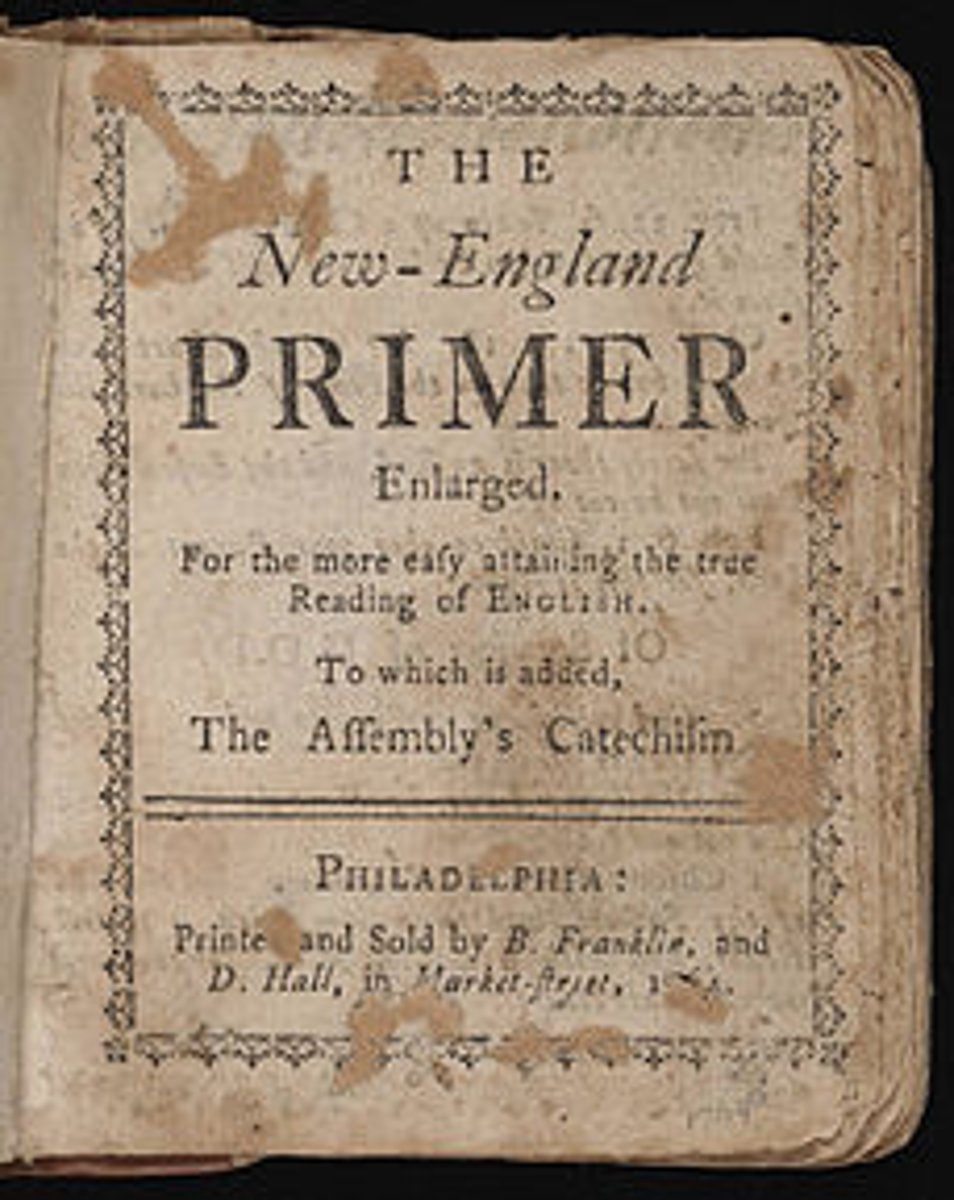
Bacon's Rebellion
A rebellion lead by Nathaniel Bacon with backcountry farmers to attack Native Americans in an attempt to gain more land.
Type: Inter-elite conflict, but rallied poorer colonists. Leaders: Nathaniel Bacon vs. Governor William Berkeley.
Motivations: Promises of lower taxes and personal freedom. Seizure of Native lands for expansion.
Bacon rallied poor whites, indentured servants, and some enslaved Africans to fight against Native Americans and the colonial government, promising lower taxes and land access. The rebels burned Jamestown and briefly controlled the colony, but Bacon died, the rebellion was crushed, and 23 followers were executed. The rebellion's long-term effect was a shift toward African slavery and the development of racial divisions, as elites sought a more controllable labor force and to prevent future multi-class uprisings.

Mary Rowlandson
A Narrative of the Captivity and Restoration of Mrs. Mary Rowlandson.
Genre: Captivity narrative — the first uniquely American literary genre.
Considered the first American literary genre. Influenced later American literature by showing the colonial experience, survival, and faith under threat.
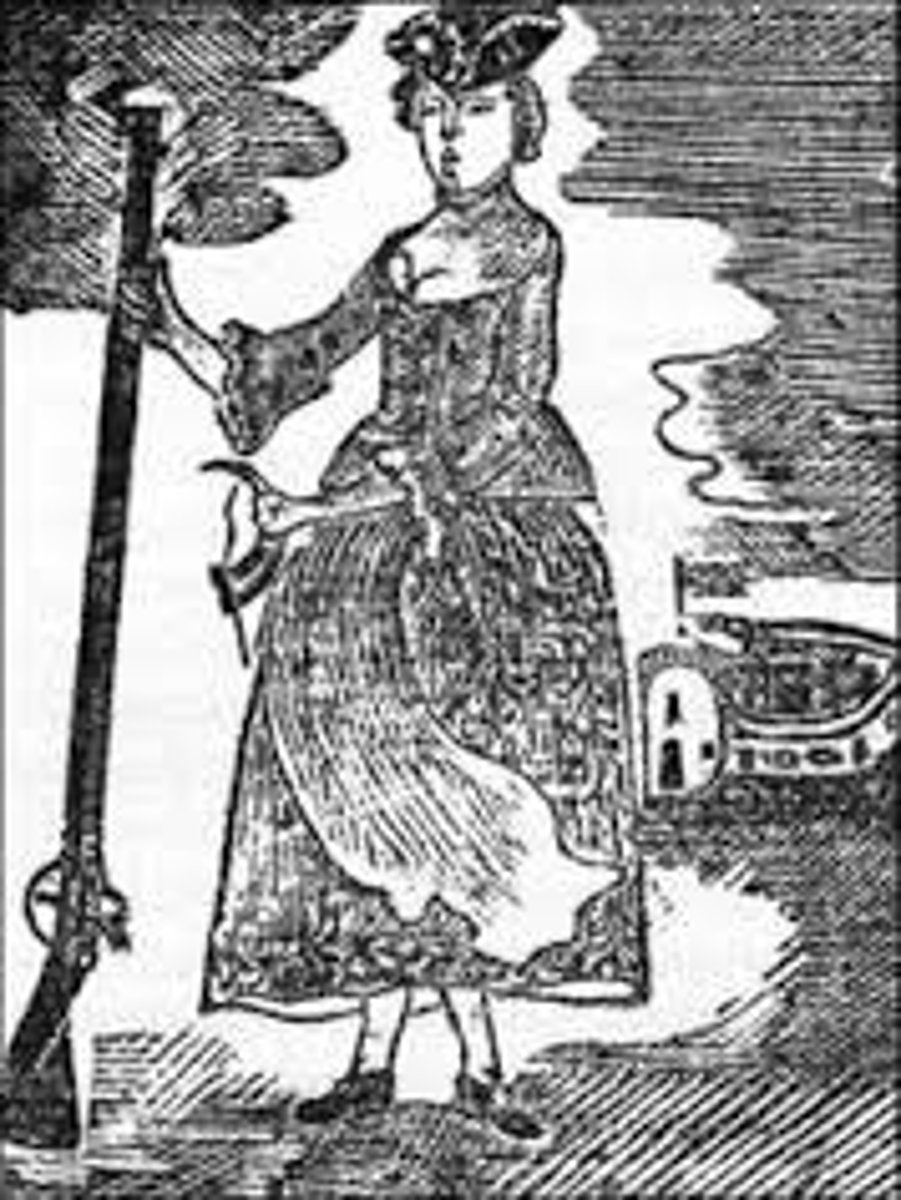
Dominion of New England
An administrative union of English colonies in the New England region of North America.
Political reorganization imposed by England.
Purpose: Centralize control over multiple colonies and enforce royal authority.
Taxation without consent: Colonists were taxed without approval of local legislatures.
The Dominion of New England (1686-1689) was a political reorganization by England that combined several colonies, Massachusetts, Connecticut, Rhode Island, New Hampshire, New York, and East & West Jersey, under a single royal administration. Colonists faced taxation without their consent, curtailed courts, and restricted town meetings, while old charters were revoked, seen as a breach of their rights. The Dominion ended after the Glorious Revolution (1688-1689) in England, which led to the restoration of colonial self-government and charters. The episode highlighted growing tensions between royal authority and colonial autonomy, setting a precedent for resistance to centralized control.
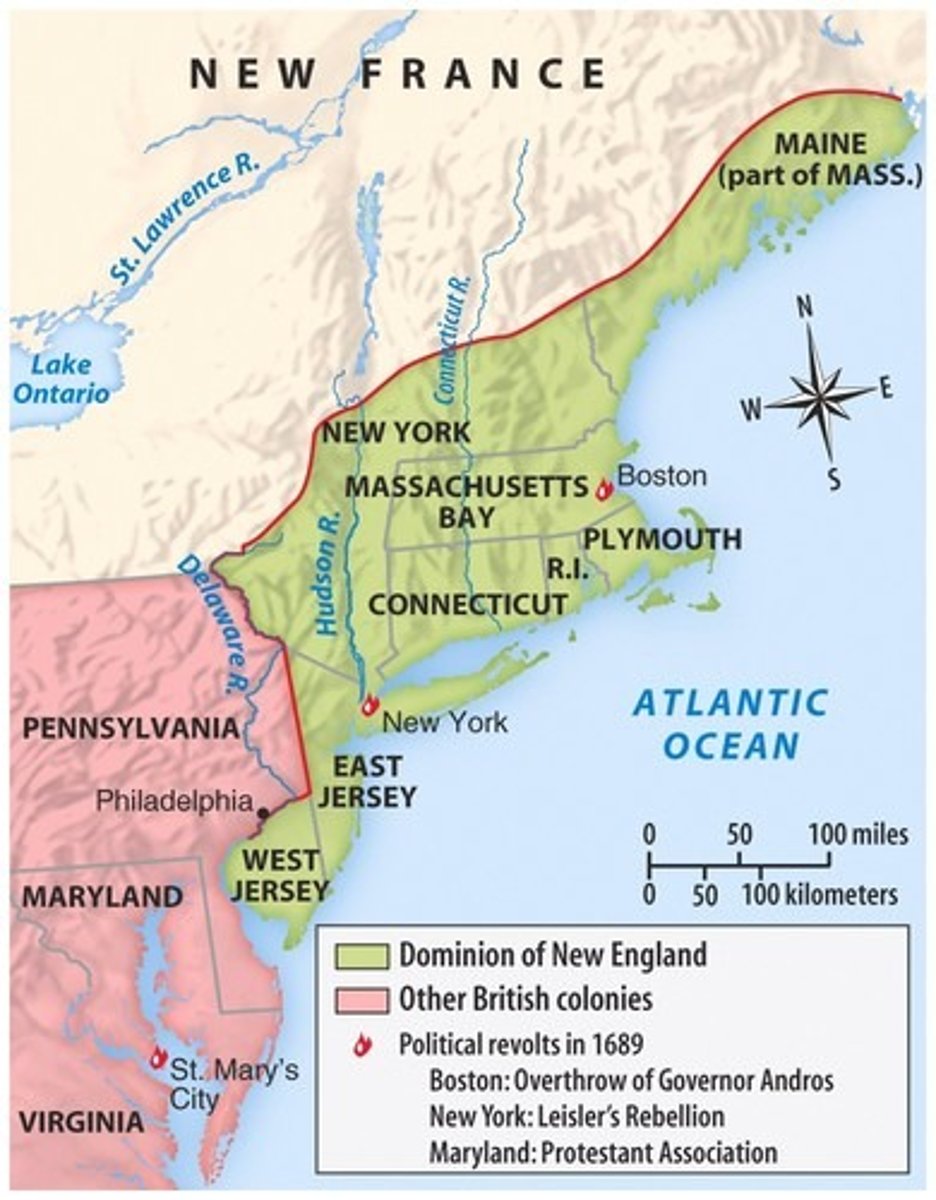
Piracy
Most of the pirates in the Caribbean during the 1600s were white Europeans, usually from England, the Netherlands, France, or Spain. Many were former sailors, privateers, or ex-navy men who turned to piracy when opportunities for wealth were limited.
Piracy expanded in the Caribbean, often blending with semi-pirate paramilitary navies. Pirates relied heavily on the wealth of Spanish silver fleets, such as when Piet Hein captured a Spanish fleet in 1628, and focused on areas that Spain had abandoned but could serve as bases for raids. Key pirate hubs included St. Domingue, Jamaica, the Bahamas, and even cities like Charleston, South Carolina; New York, New York; and Newport, Rhode Island. Piracy thrived by exploiting Spanish wealth and gaps in imperial control, making it both an economic and cultural force in the Atlantic world.
Key Pirate Bases: St. Domingue, Jamaica, Bahamas.
- Piracy exploited gaps in imperial control and Spanish wealth.

Decline in Piracy
Reason: North American mainland colonies had become stable and economically valuable; maintaining law and social order was now more important than raiding Spanish wealth.
Pirates often crossed racial, national, and class lines, challenging the strict hierarchies of colonial society.

Late Colonial Life in North America
Rapid population growth: Mainland British North America doubled every 20-25 years.
Consumer revolution: Colonists increasingly purchased imported goods, showing growing wealth and connection to the Atlantic economy.
High literacy rates: Especially in New England, where Puritan emphasis on reading the Bible boosted literacy.
Salutary neglect: British government loosely enforced laws and trade regulations, allowing colonies some self-governance and economic experimentation.
These factors set the stage for colonial cohesion and eventual resistance leading up to the American Revolution.
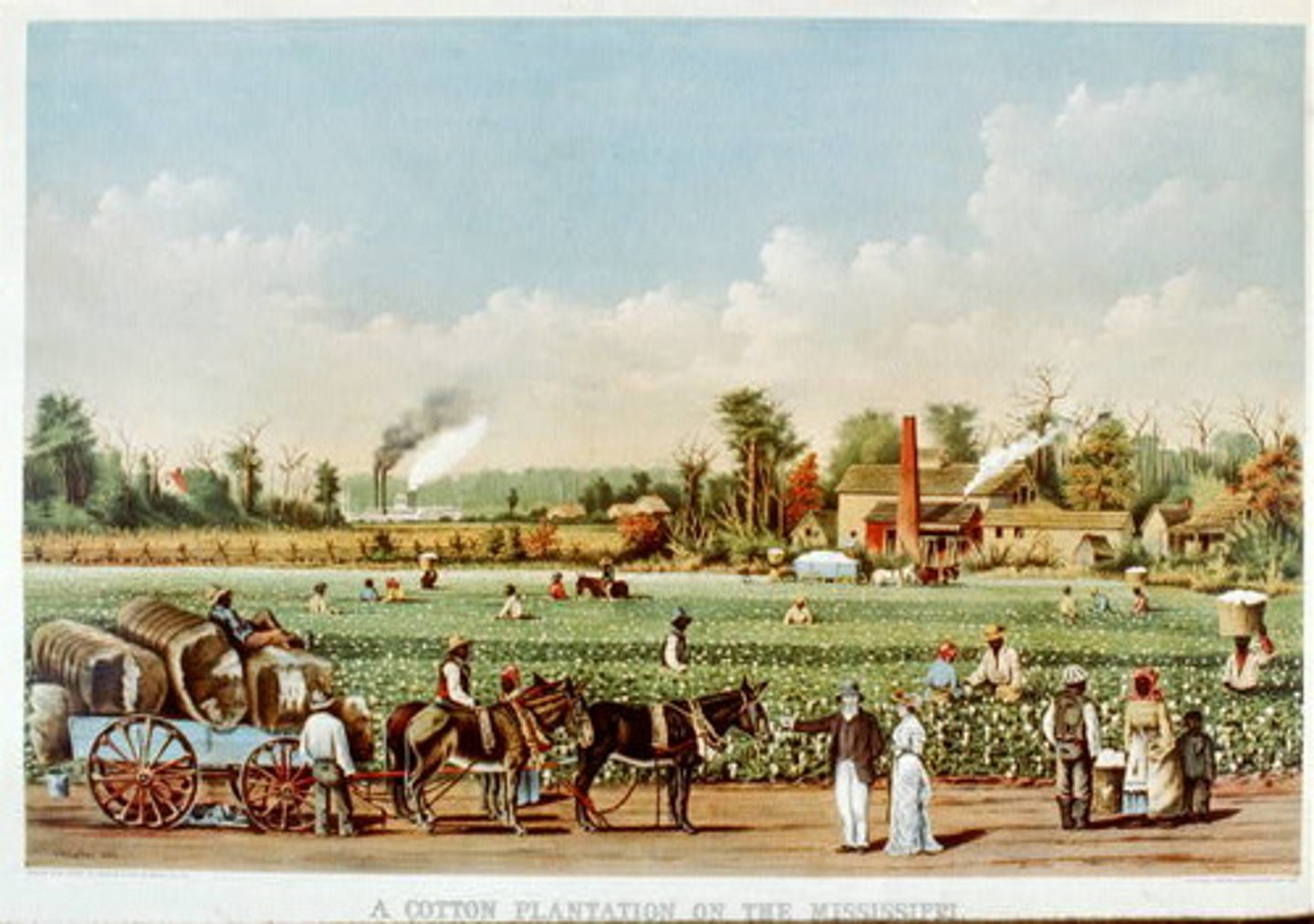
Stamp Act
1765; law that taxed printed goods, including: playing cards, documents, newspapers, etc.
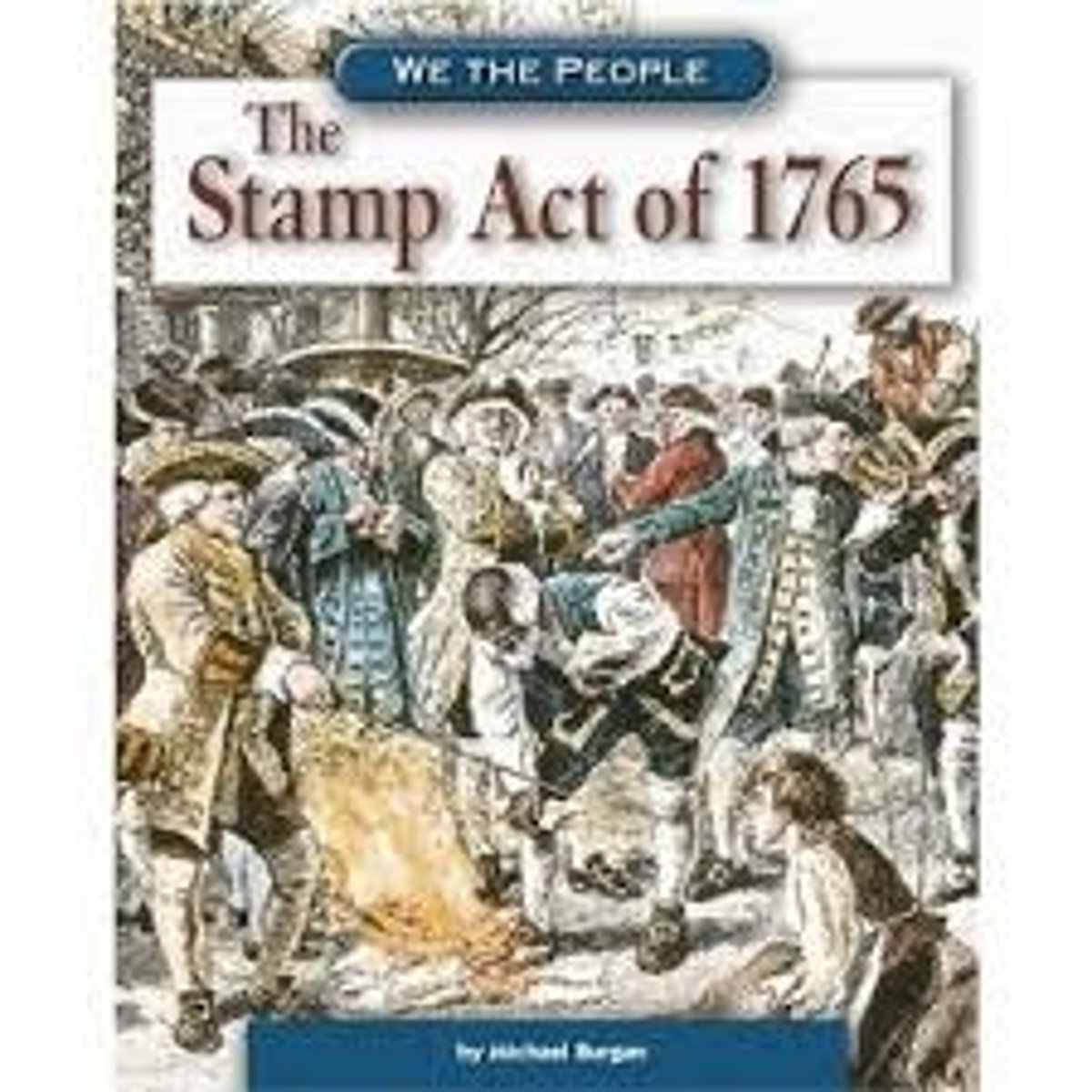
Seven Years' War
A global conflict with multiple theaters: India, Caribbean, Latin America, Africa, Pacific, Europe, and North America. Highlighted the global nature of colonial competition, with conflicts not just local but part of worldwide imperial struggles.
Resulting in significant British territorial gains and the rise of Britain as a leading empire.
- Britain captured Quebec City, a major French stronghold in Canada.
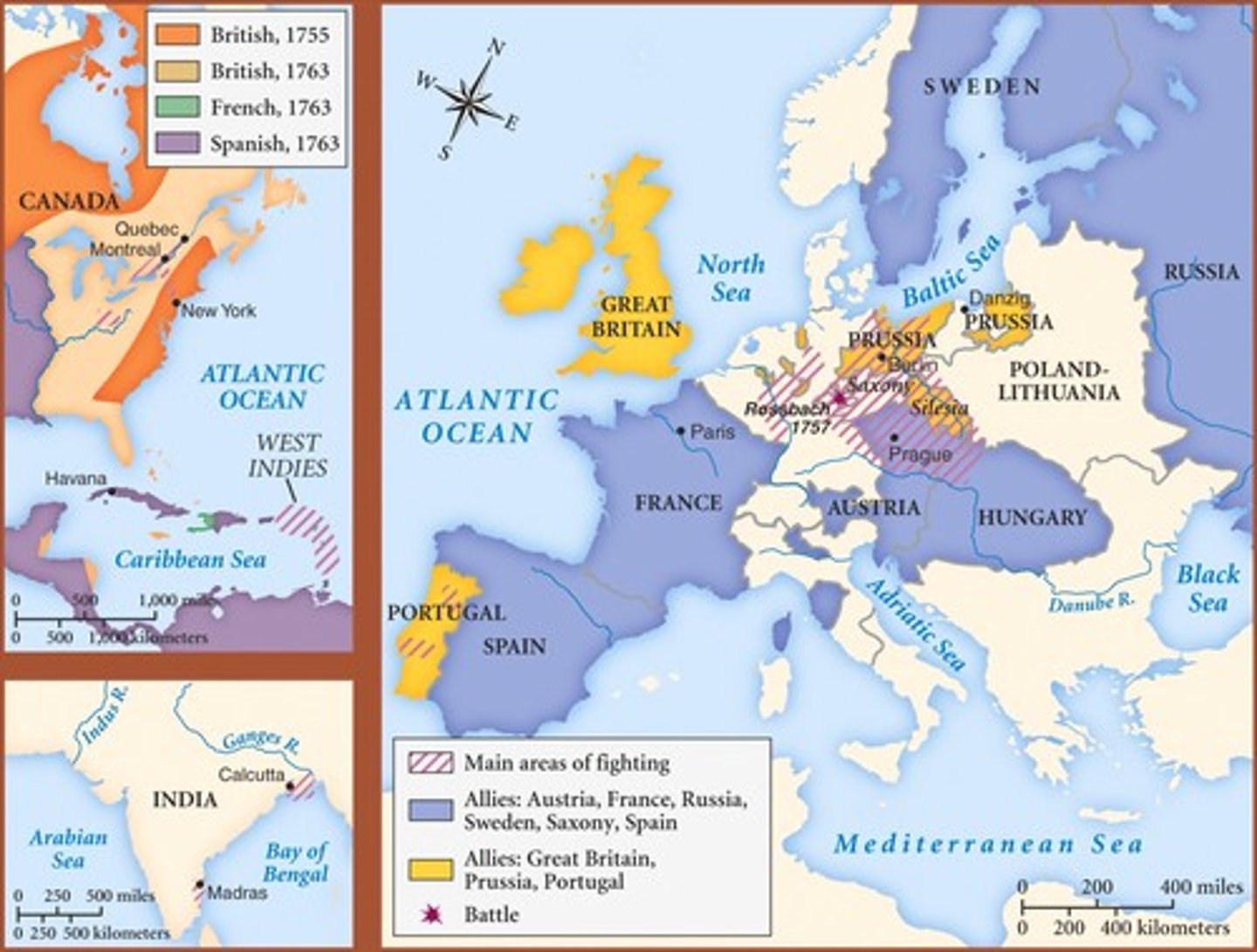
Maya
Most developed writing system in the Americas. Known for Art, Mathematics, Astronomy, and Calendars.
The Spanish invasion of the Maya region began in the early 16th century, introducing diseases and sustained military pressure.
Final Maya City Falls (1697)

Gladiatorial sacrifice
"bro" is supposed to fight to show courage and honor in a losing battle, which the Aztecs believed was the most valuable offering possible.
Aztec gladiatorial sacrifice was a ritual combat, called Tlacaxipehualiztli, where a captured warrior was tied to a stone platform, given a mock weapon, and forced to fight against trained Aztec warriors. The goal was not necessarily to kill him, but to showcase the victim's bravery. If he defeated six Mexica warriors, he would be granted his freedom. If he was defeated, his heart would be cut out in a sacrifice to the gods, particularly the god Xipe Totec.

Hernan Cortes
Spanish conquistador who defeated the Aztecs and conquered Mexico (1485-1547)
RUTHLESS MAN!!!

La Malinche
She was the interpreter for Cortes. She helped the Spanish make their way into Tenochtitlan.
(THE MOTHER OF MESTIZO / TRAITOR)
She remains a controversial and symbolic figure in Mexico, viewed by some as a traitor to her people (malinchista) and by others as the symbolic mother of the modern Mexican Mestizo (mixed-race) nation, as she bore Cortés's son, Martín.
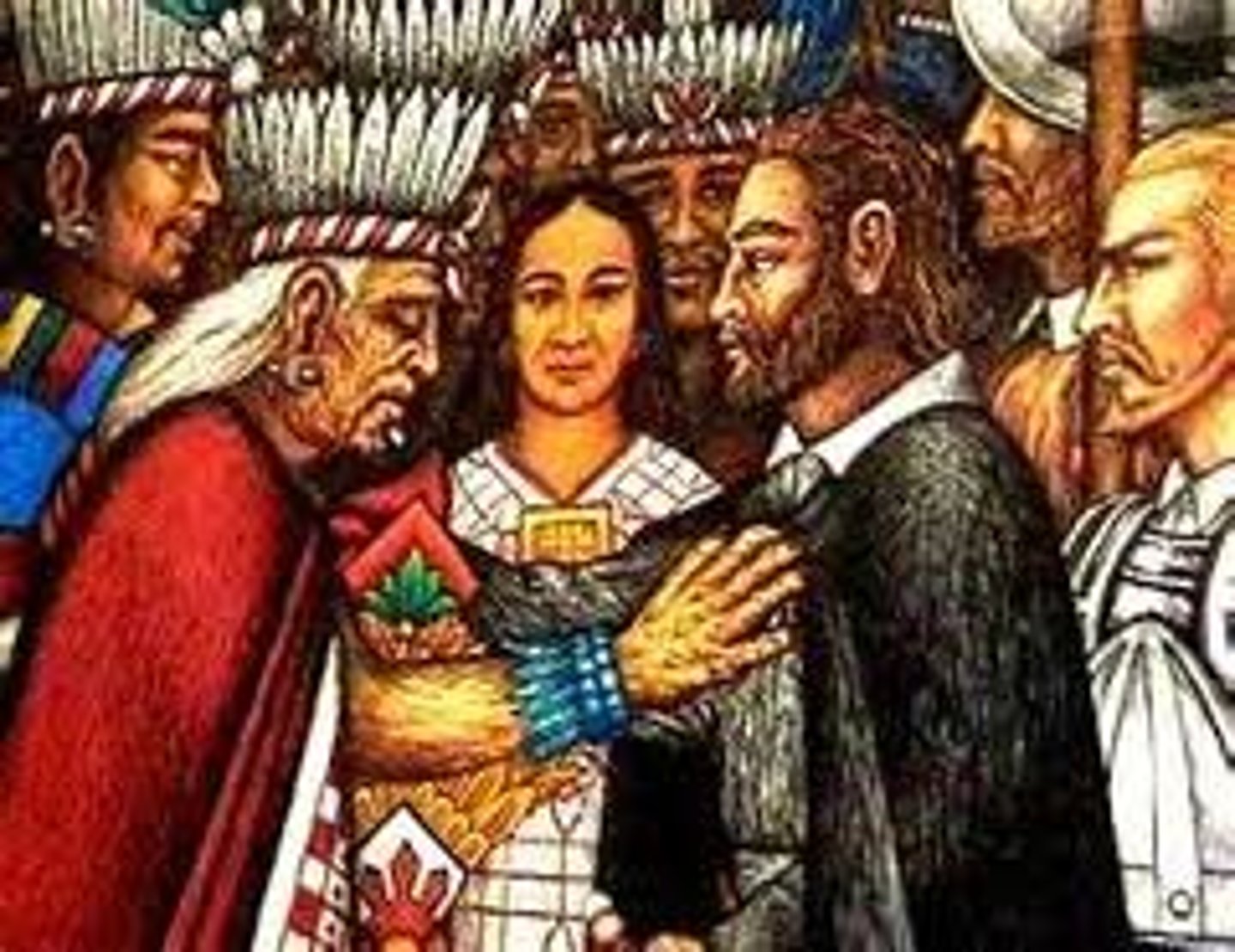
Tenochtitlan
Capital of the Aztec Empire, located on an island in Lake Texcoco. Its population was about 150,000 on the eve of Spanish conquest. Mexico City was constructed on its ruins.
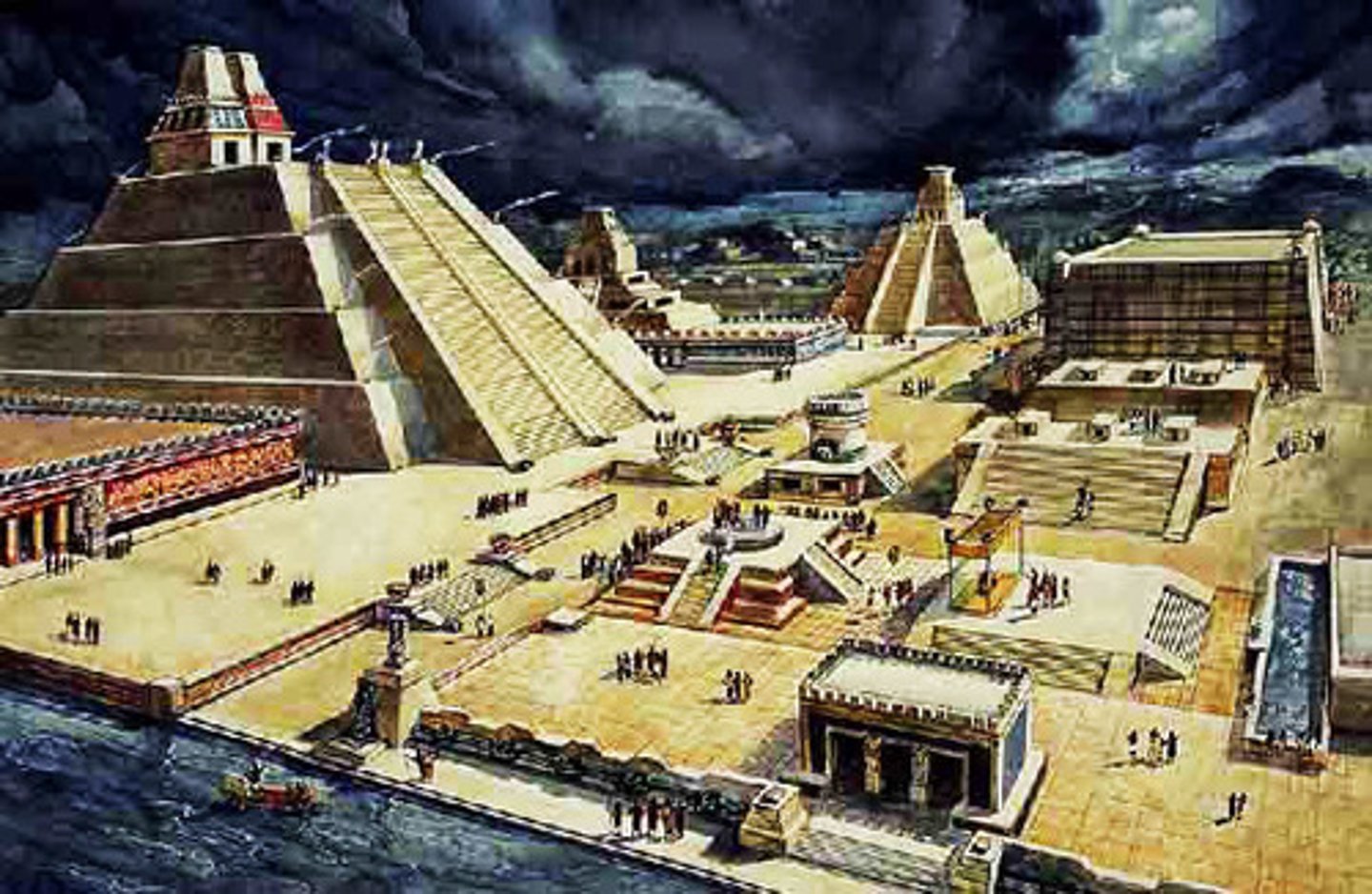
Reconquista
Historical period during which the Catholic kingdoms of the Iberian Peninsula fought to reclaim territories under Muslim control.
Influence on Conquest: This process profoundly shaped the mindset of the conquistadores like Cortés. It instilled a powerful ideology of religious warfare, military zeal, and the justification of conquest over non-Christians.
Institutions: The systems of land distribution and forced labor used in the Americas, such as the encomienda, were directly influenced by practices developed during the Reconquista.
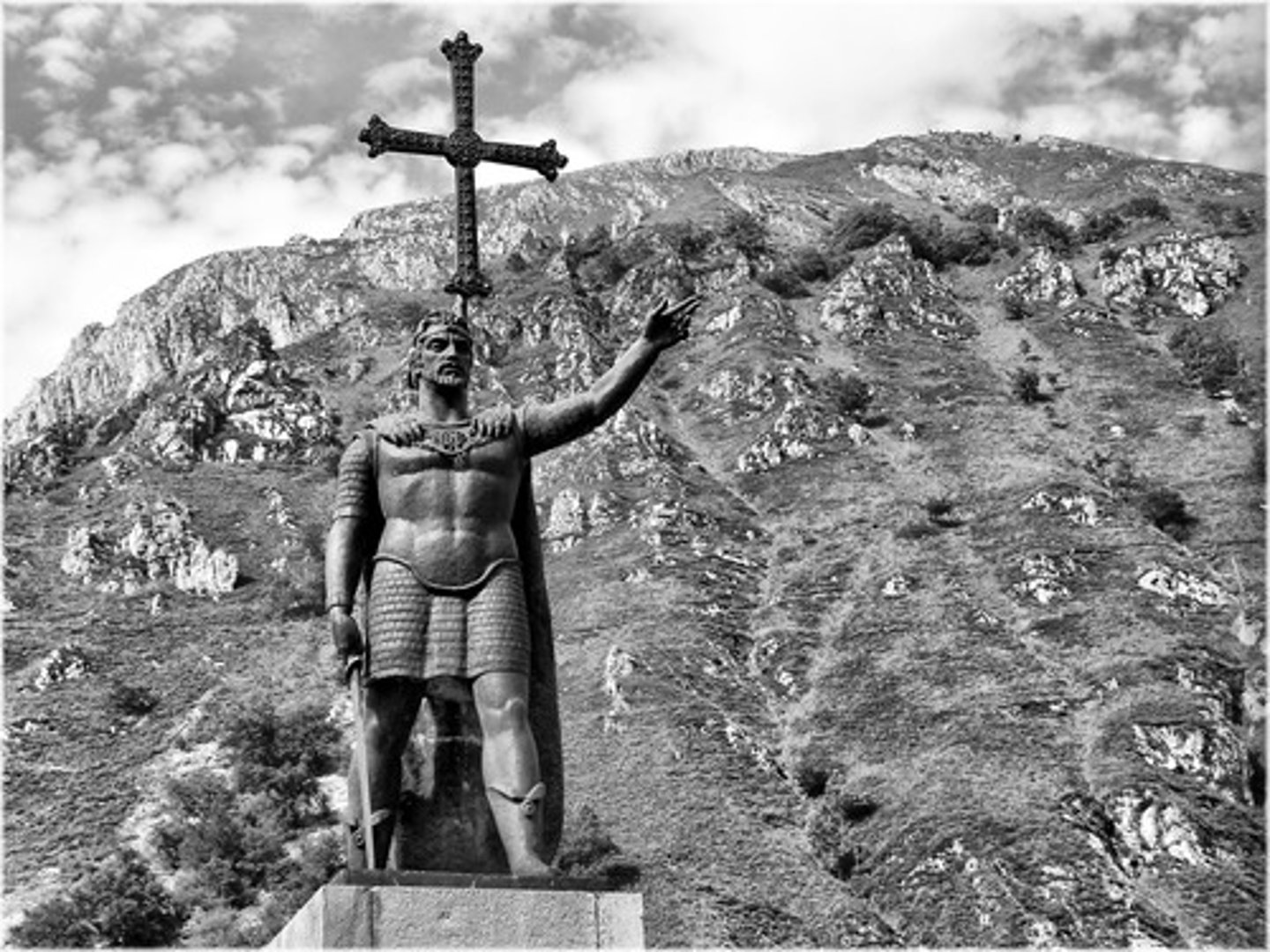
Inca
Largest and most powerful Andean empire. Controlled the Pacific coast of South America from Ecuador to Chile from its capital of Cuzco.

Quipu
An arrangement of knotted strings on a cord, used by the Inca to record numerical information.
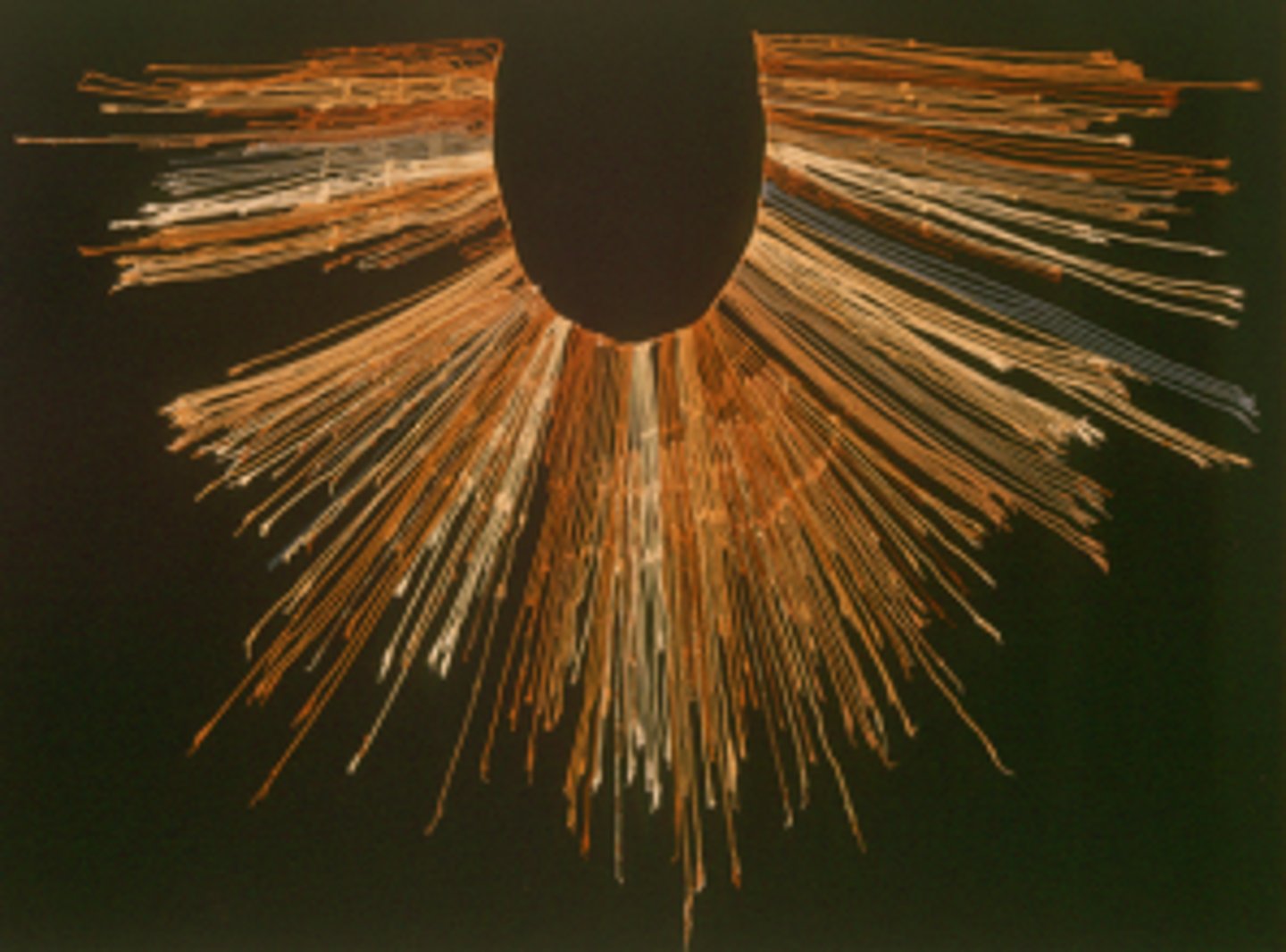
Francisco Pizarro
Spanish explorer who conquered the Incas in what is now Peru and founded the city of Lima (1475-1541).
Francisco Pizarro, with a small force of Spanish conquistadors, led the campaign that toppled the vast Inca Empire in the early 1530s, seeking immense wealth in gold and silver.
Arrival and Civil War: Pizarro arrived in Peru in 1531 with about 180 men, taking advantage of a devastating situation: the Inca Empire was weakened by a civil war between two royal half-brothers, Huáscar and Atahualpa, who were vying for the throne.
The Capture of Atahualpa (Cajamarca, 1532): Pizarro ambushed the victorious Inca Emperor, Atahualpa, at a meeting in the city of Cajamarca.
The Ransom and Execution: Atahualpa offered an enormous ransom: filling a large room once with gold and twice with silver. Pizarro accepted the ransom, which yielded a staggering amount of wealth for the Spanish Crown and the conquistadors.
Fall of the Capital: After Atahualpa's death, Pizarro marched to the Inca capital of Cuzco, capturing it in November 1533.
Columbian Exchange
The exchange of plants, animals, diseases, and technologies between the Americas and the rest of the world following Columbus's voyages.
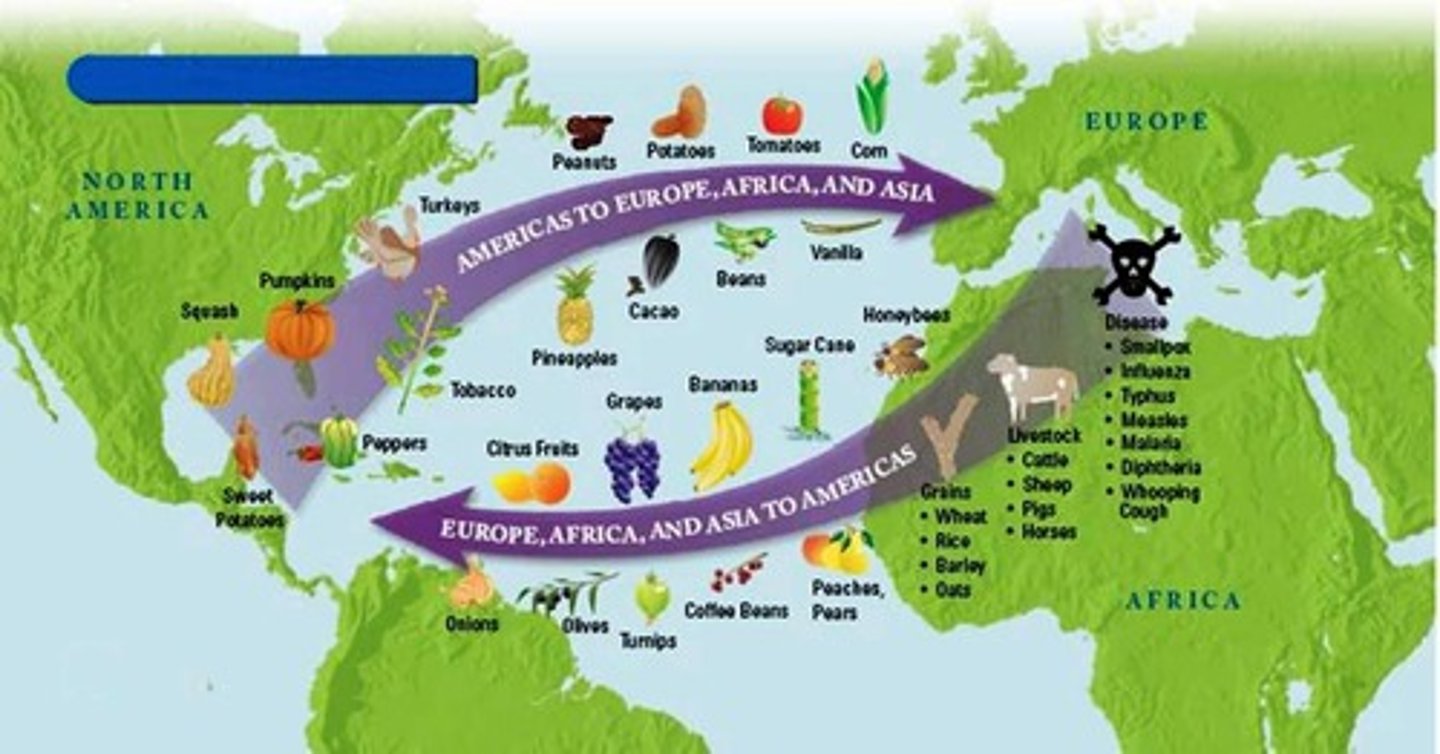
Native Americans Propaganda
It Frames the Native as Needy: The image depicts the Native man not as a sovereign individual or a warrior defending his land, but as a helpless figure pleading for European aid. This directly supports the English colonists' claim that they were arriving on a "mission of mercy"—a civilizing, benevolent mission to help the Indigenous people, not conquer them.
Religious and Moral Mandate: The "help" requested by the Native figure was understood by the Puritan settlers to be salvation (bringing Christianity) and civilization (bringing English governance and culture).
A Symbol of Legitimate Expansion: By depicting the inhabitants as requesting the presence of the English, the Seal symbolically legitimized the colony's expansion and resource appropriation, masking the displacement and violence that colonization actually entailed.
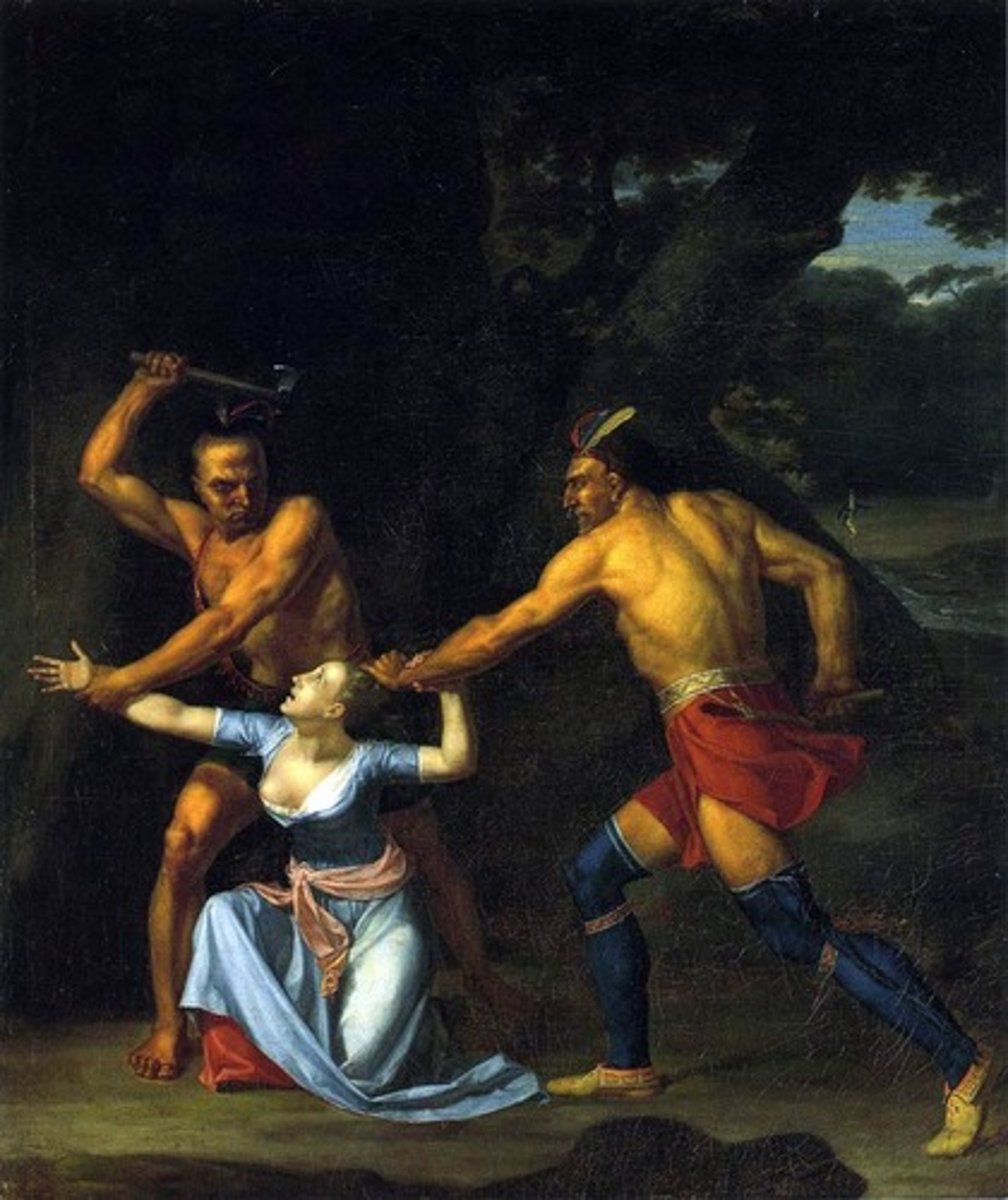
Plantations in Ireland
The term "plantation" itself was first used to describe these settlements in Ireland. This system involved establishing new settlements by transporting English and Scottish settlers (planters) to displace or subordinate the native Catholic Irish population.
The Irish Plantations served as a crucial "dress rehearsal" for English colonization in North America.
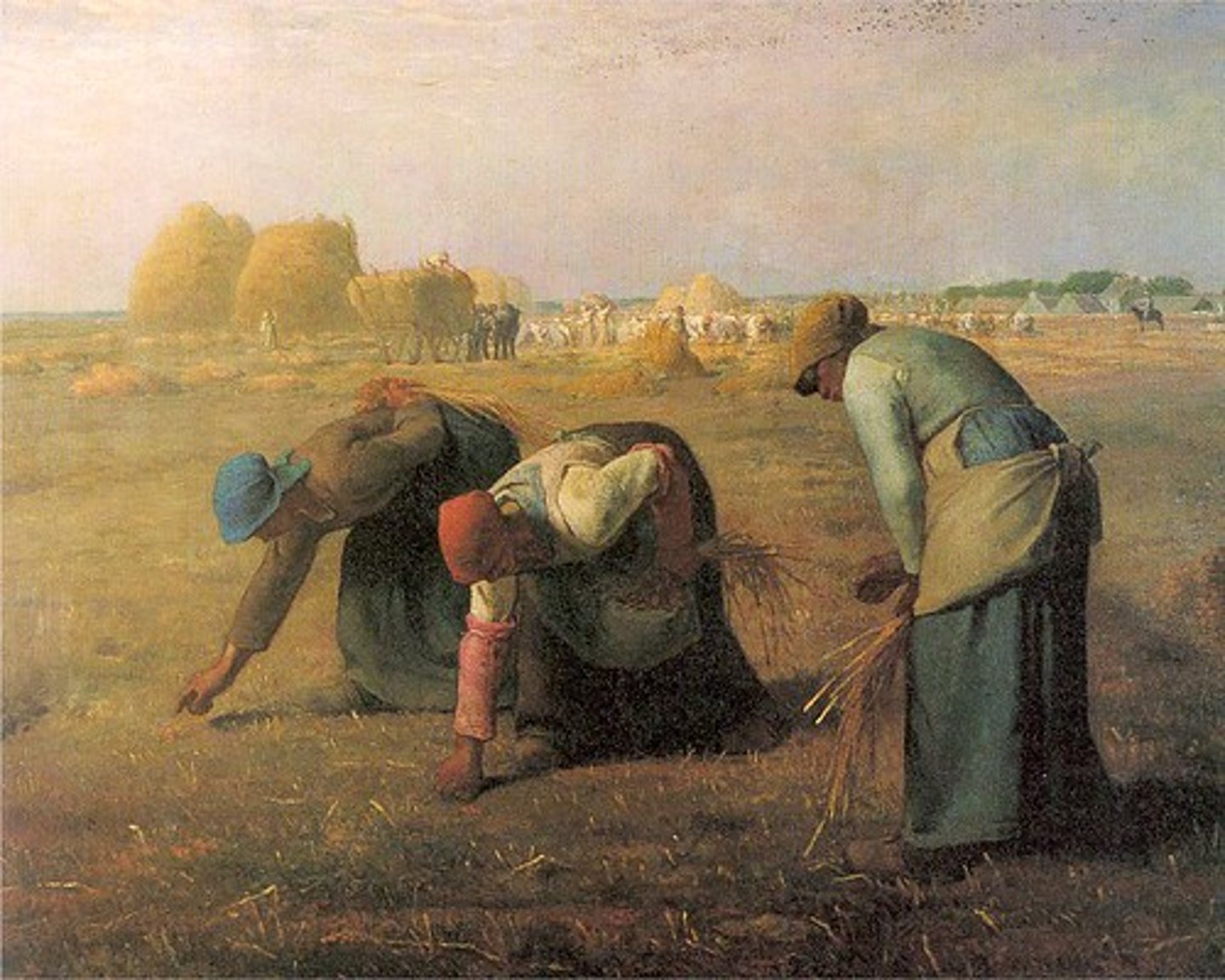
Roanoke
Established in 1587. Called the Lost Colony. It was financed by Sir Walter Raleigh, and its leader in the New World was John White. All the settlers disappeared, and historians still don't know what became of them.
Jamestown
The first permanent English settlement in North America, found in East Virginia.
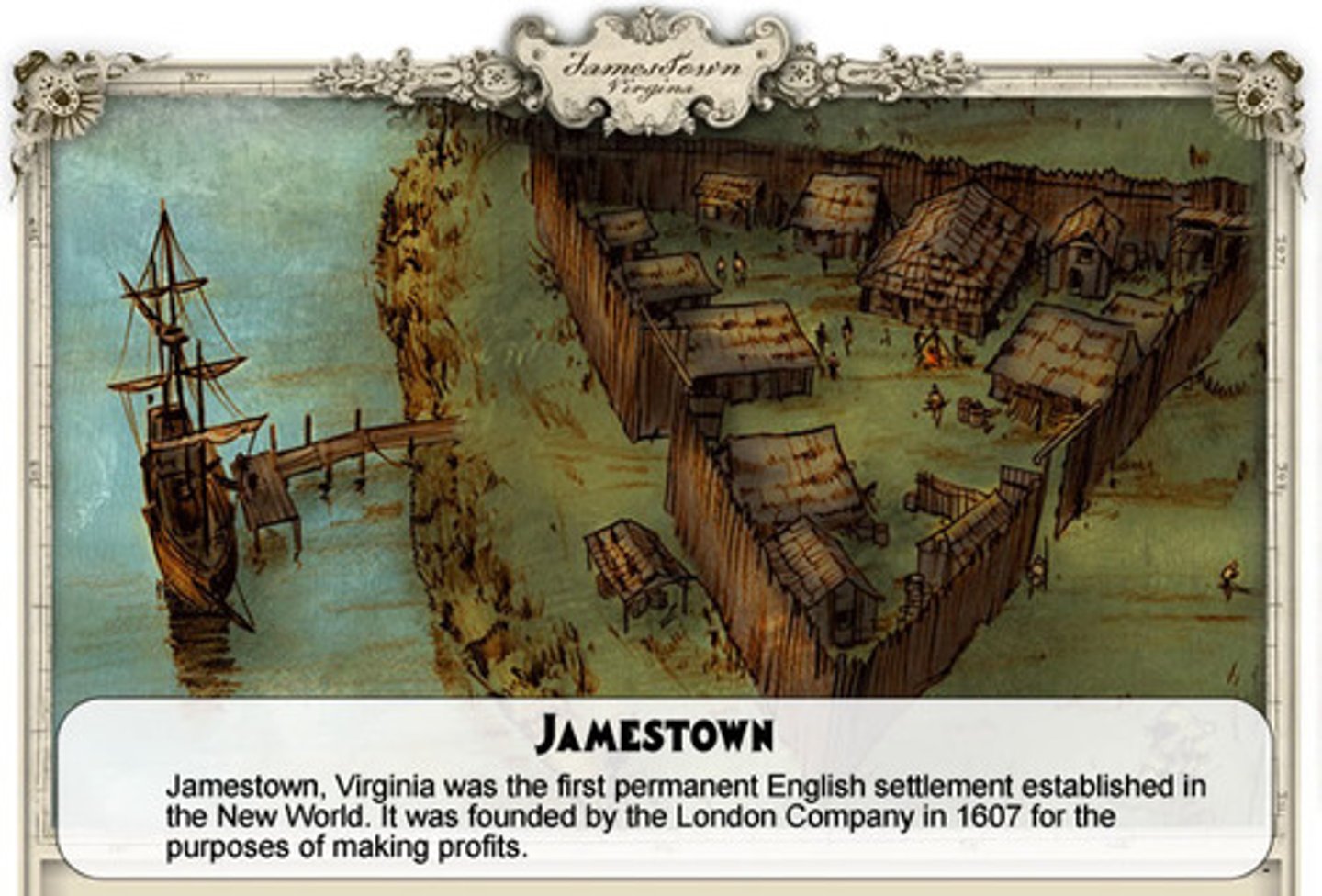
Plymouth
Colony settled by the Pilgrims. It eventually merged with Massachusetts Bay colony.
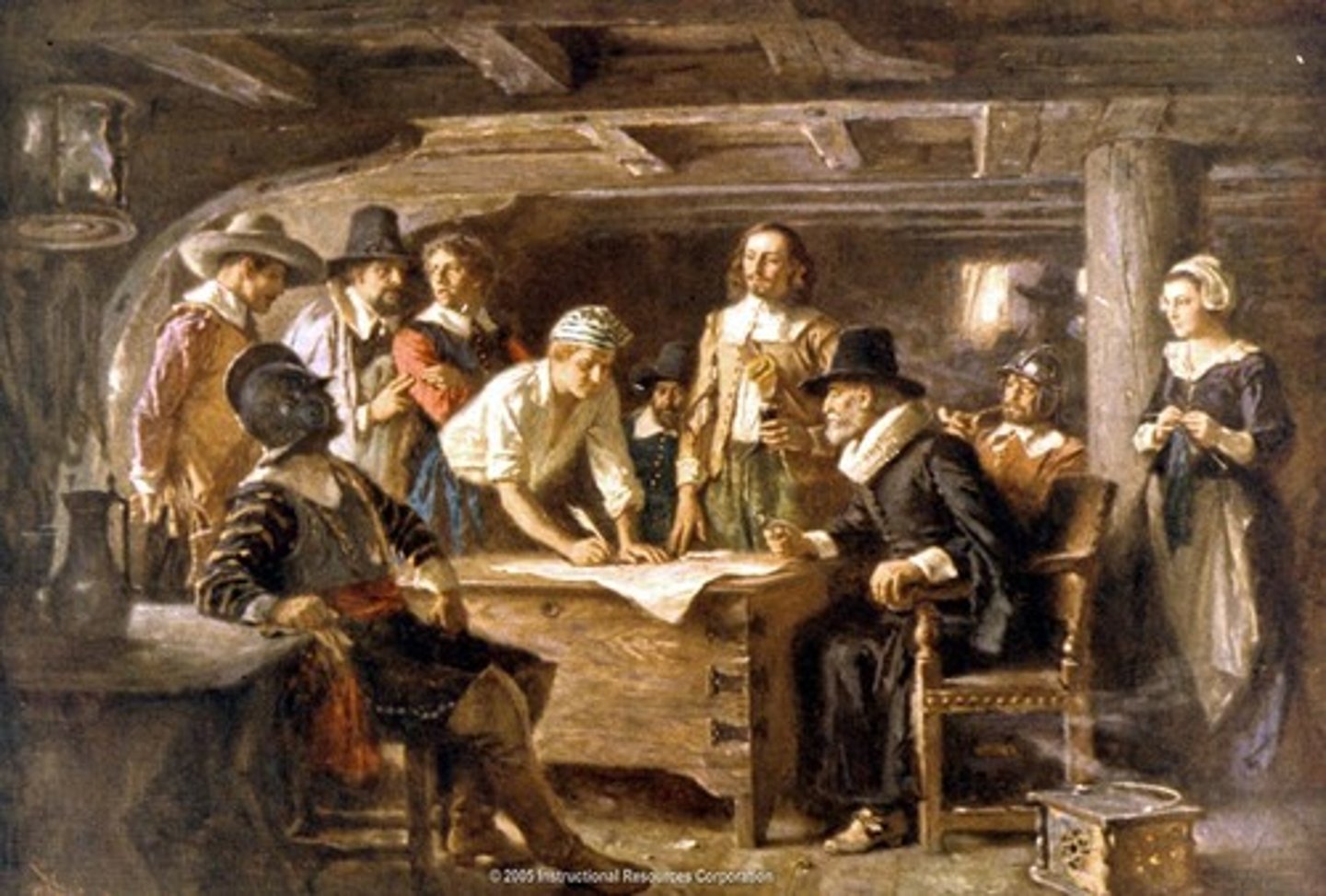
Quakers
English dissenters who broke from Church of England, preached a doctrine of pacificism, inner divinity, and social equity, under William Penn they founded Pennsylvania.
- Protestant reformers who believe in the equality of all people.
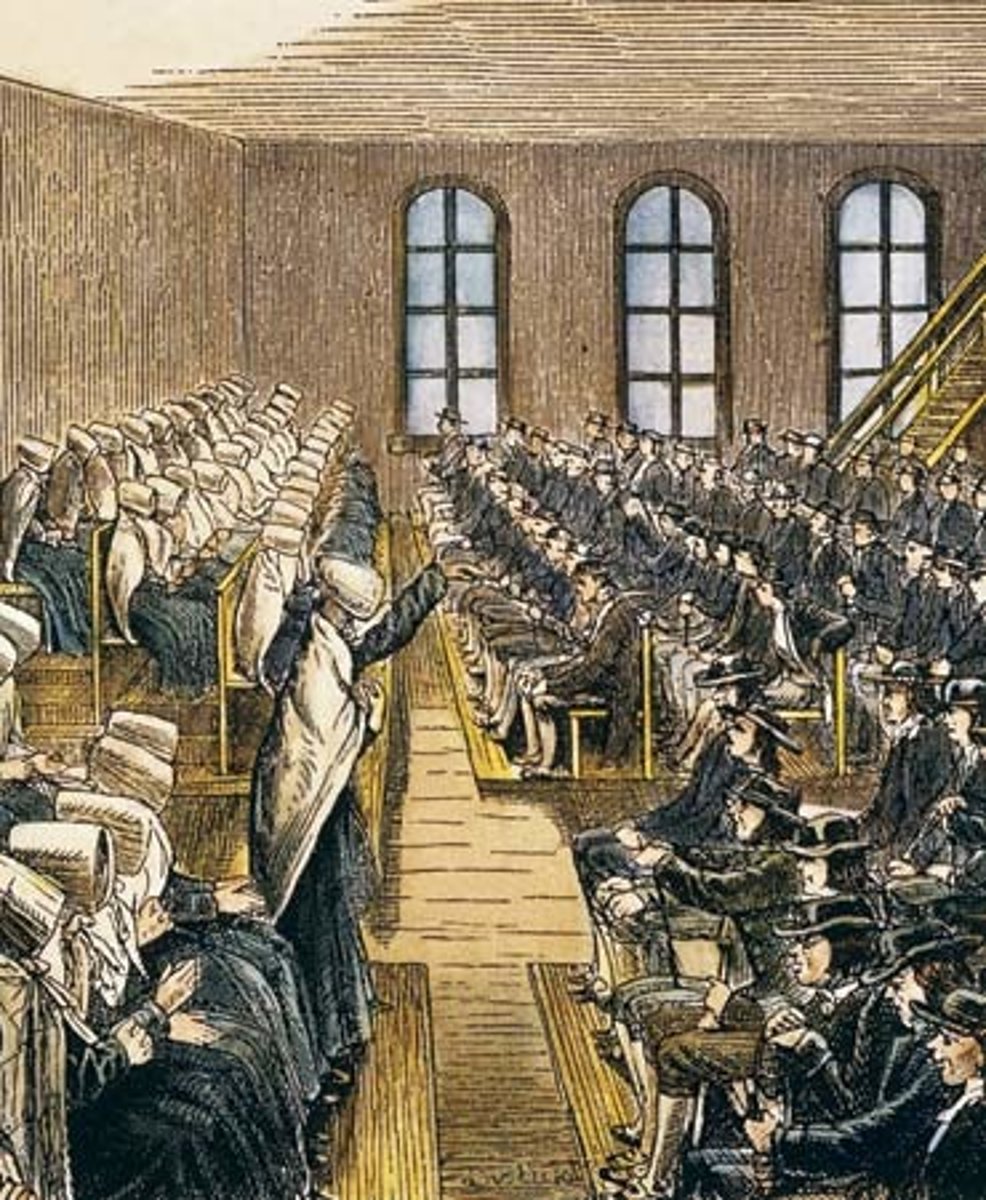
Powhatan
Indian chief and founder of the Powhatan confederacy of tribes in eastern Virginia.
Expansion of power: He grew the alliance from six tribes he inherited to include up to 30 other tribes, requiring them to pay tribute in the form of food, furs, and other goods.
Family: He was the father of Pocahontas, who later married English colonist John Rolfe, which helped to temporarily end years of conflict between his people and the English.
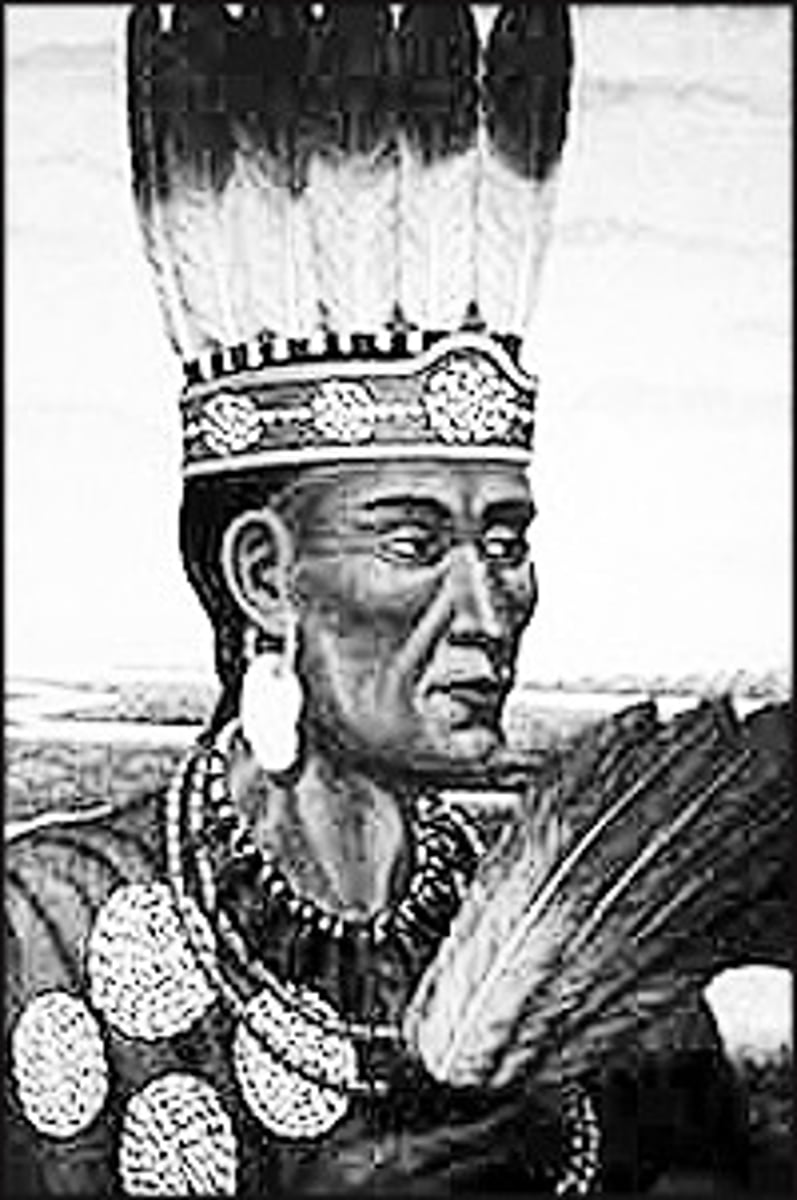
Powhatan confederacy
Group of Native Americans who traded with John Smith.
This confederacy was crucial in early interactions with English settlers at Jamestown, engaging in a mix of trade and conflict over land and resources. The confederacy was a sophisticated political structure that allowed for collective decision-making and defense among its member tribes.

Squanto
In 1614, Squanto was kidnapped by an English explorer, taken to Spain, and sold into slavery. He eventually escaped, learned to speak English, and returned to North America in 1619. Upon his return, he discovered that a plague brought by Europeans had killed nearly his entire tribe, the Patuxet. He then went to live with the neighboring Wampanoag people.
He became an indispensable intermediary for the Plymouth settlers, teaching them crucial survival skills like planting corn and helping them negotiate a peace treaty with the Wampanoag chief, Massasoit.
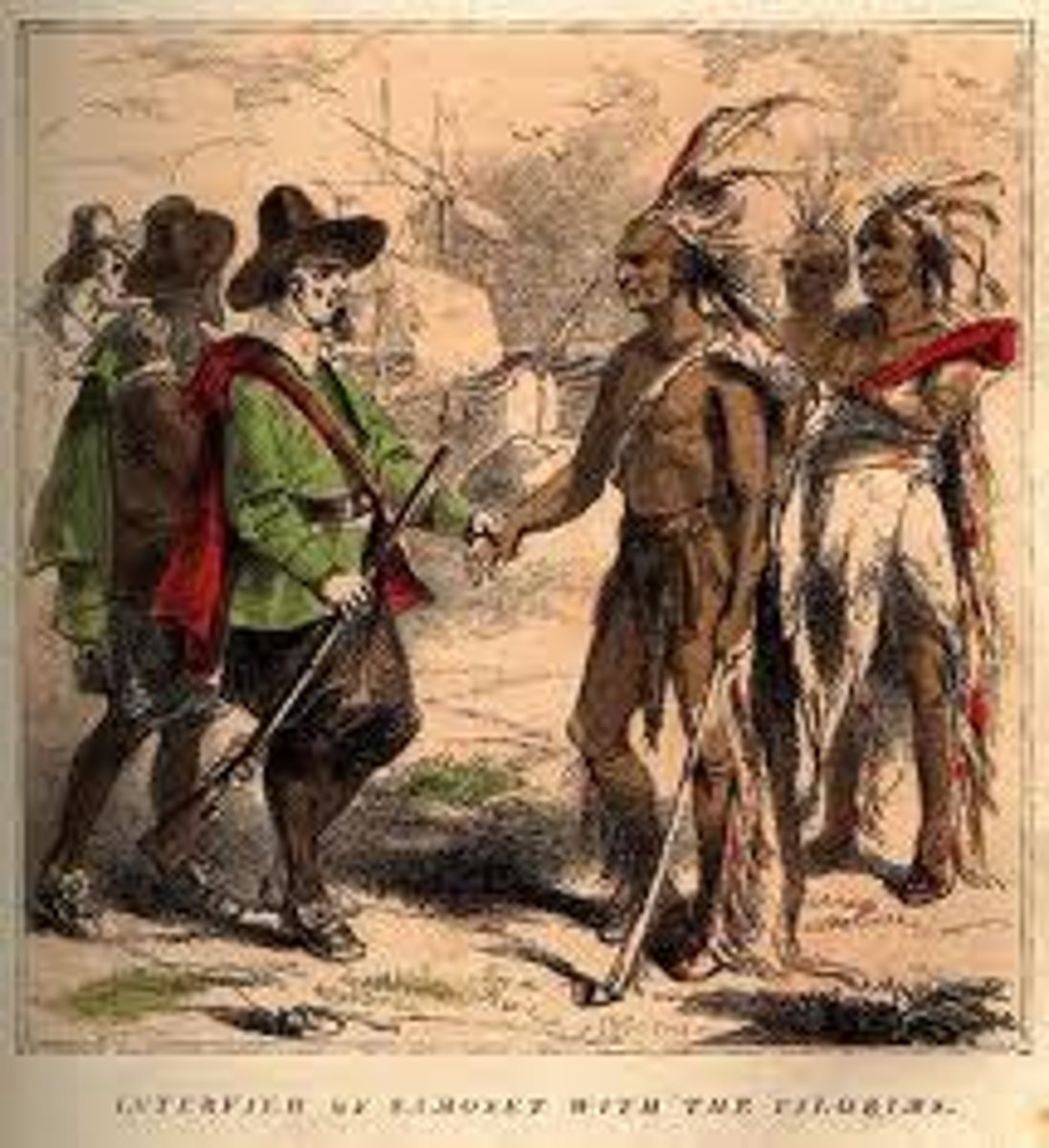
Plains horse culture
The cultural transformation of many Plains tribes following the Spanish introduction of horses to the Americas in the 16th century. The horse became central to their nomadic lifestyle, enabling faster and more efficient buffalo hunting, increasing wealth and status, and transforming warfare, social structure, and even artistic expression.

Indian Removal Act (1830)
A congressional act (President Andrew Jackson) that authorized the removal of Native Americans who lived east of the Mississippi River. (forced relocation of Native American tribes.)
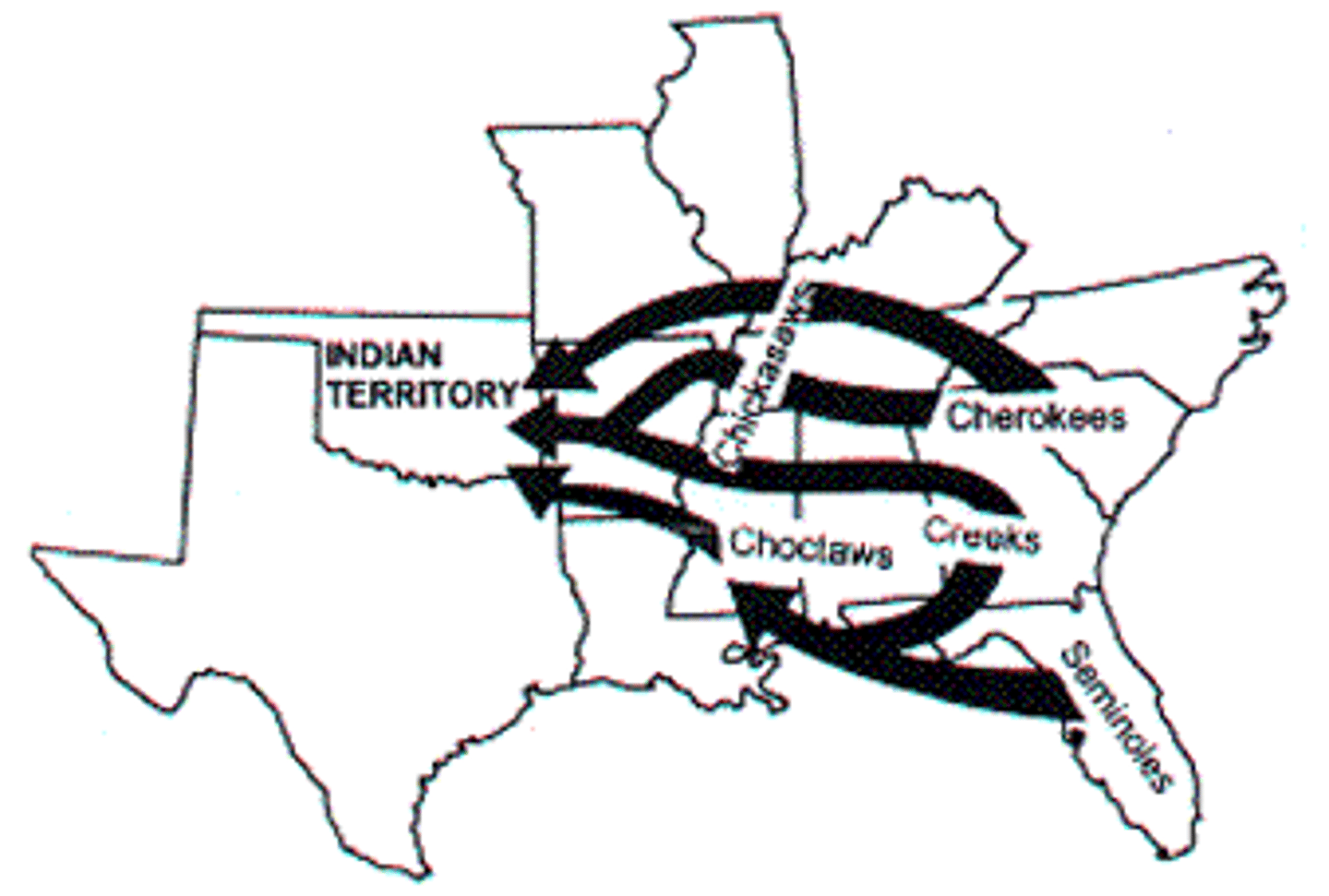
American Indian Movement
a civil rights group organized to promote the interests of Native Americans

Wounded Knee Massacre
mass killing by U.S. soldiers of as many as 300 unarmed Sioux at Wounded Knee, South Dakota, in 1890
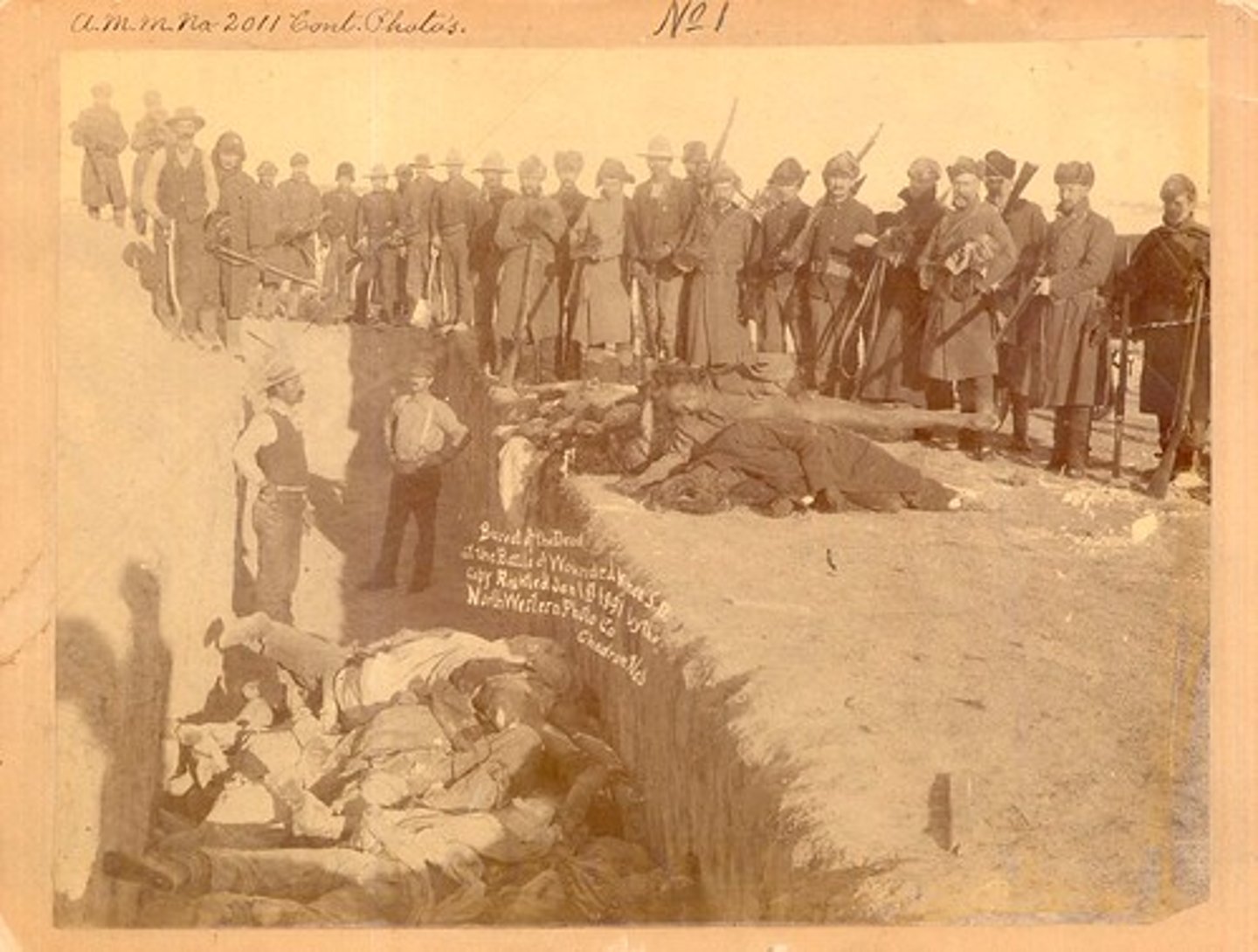
The Deciding Authority: State vs. Tribe
The Imperial/National State's Role
Historically, the U.S. government (the national state) has sought to control Native identity through laws and administrative procedures.
The U.S. determines which tribal entities are "federally recognized," a process that grants sovereign rights and eligibility for specific federal benefits.
The state historically imposed the concept of "Blood Quantum" (a measure of Native ancestry) to reduce the number of people legally counted as Indian, often to dismantle land claims.
The Natives Themselves (Tribal Sovereignty)
The most important and legally recognized authority lies with the Native Nations themselves. As sovereign political entities:
Tribes set their own membership requirements, an inherent right of self-governance. These requirements are detailed in their own tribal laws or constitutions.
Criteria for enrollment often include lineal descent from an individual named on a historic tribal roll, and sometimes a minimum Blood Quantum.
Homestead Act
1862 - Provided free land in the West to anyone willing to settle there and develop it. Encouraged westward migration.
